Jasper Francis Copsey
by Edward L Mooney
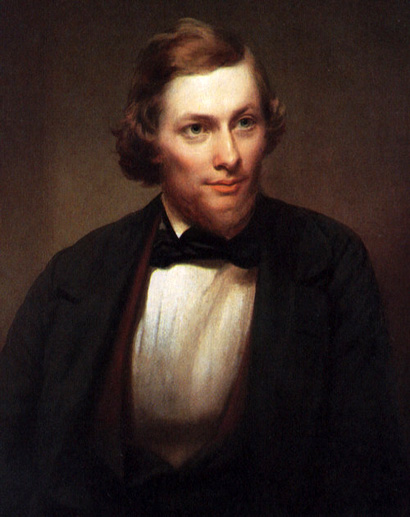
Self-Portrait of Jasper F. Cropsey
Date Unknown
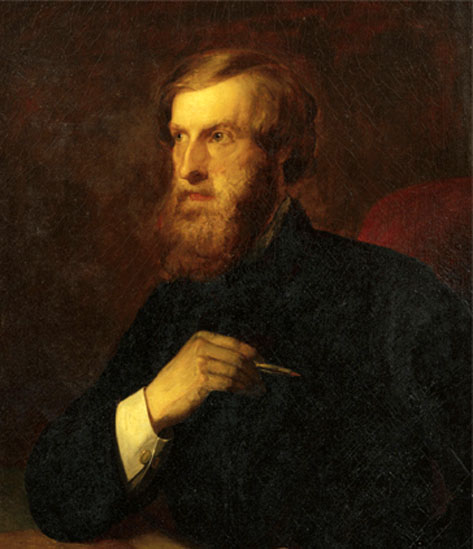
Jasper Francis Cropsey was an important American landscape artist of the Hudson River School.
Cropsey was born on his father Jacob Rezeau Cropsey's farm in Rossville on Staten Island, New York, the oldest of eight children. As a young boy, Cropsey had recurring periods of poor health. While absent from school, Cropsey taught himself to draw. His early drawings included architectural sketches and landscapes drawn on notepads and in the margins of his schoolbooks.
Trained as an architect, he set up his own office in 1843. Cropsey studied watercolor and life drawing at the National Academy of Design under the instruction of Edward Maury and first exhibited there in 1844. A year later he was elected an associate member and turned exclusively to landscape painting; shortly after he was featured in an exhibition entitled "Italian Compositions".
Cropsey married Maria Cooley in May 1847, traveled in Europe from 1847-1849, visiting England, France, Switzerland, and Italy. He was elected a full member of the Academy in 1851. Cropsey was a personal friend of Henry Tappan, the President of the University of Michigan from 1852 to 1863. At Tappan's invitation, he traveled to Ann Arbor in 1855 and produced two paintings, one of the Detroit Observatory, and a landscape of the campus. He went abroad again in 1855, and resided seven years in London, sending his pictures to the Royal Academy and to the International exhibition of 1862.
Detroit Observatory: 1855
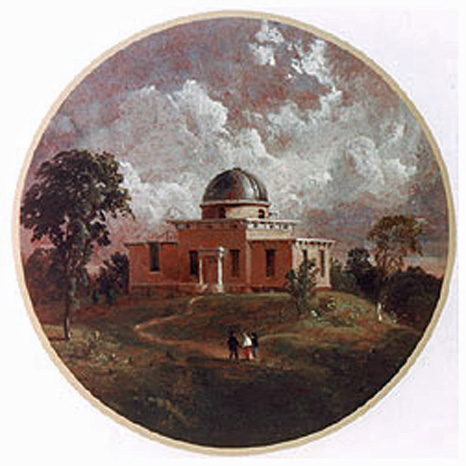
University of Michigan
by Jasper Cropsey: 1855
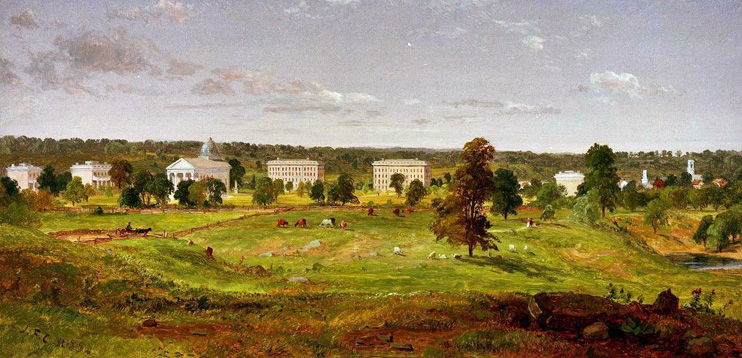
Florence: 1875
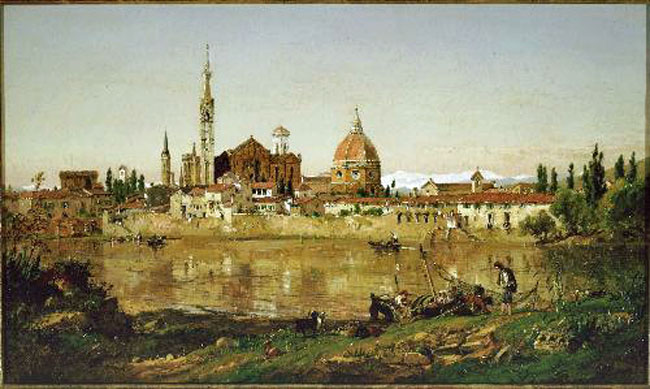
Eurpean Tour: 1855 - 1862
Bonchurch, Isle of Wight: 1859

By the Sea Lulworth: 1857
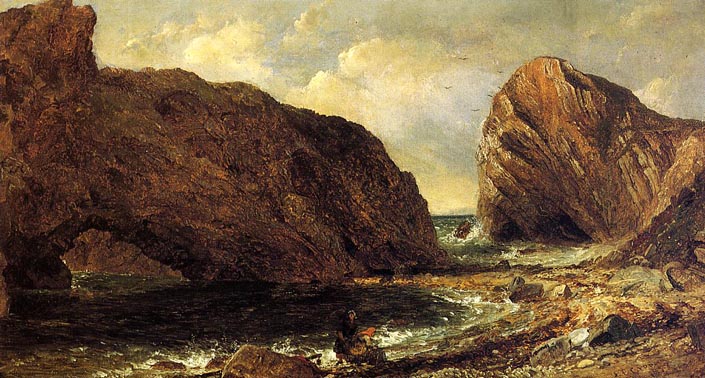
Castle by a Lake: 1855
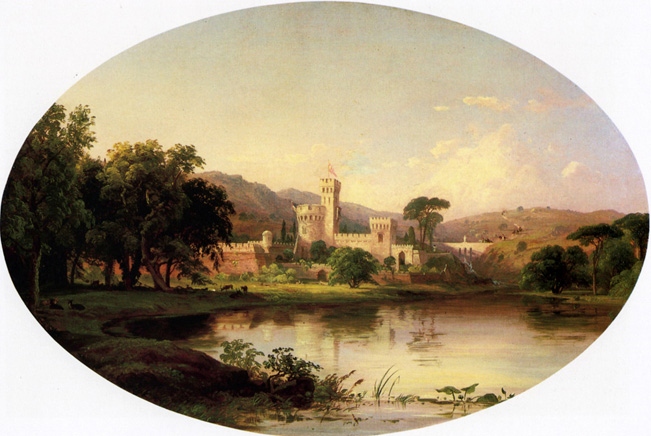
Chepstow Castle on the Wye: 1854
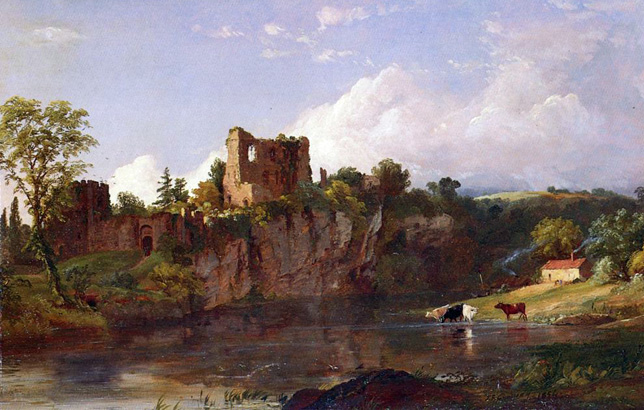
Coast of Dorset: 1858
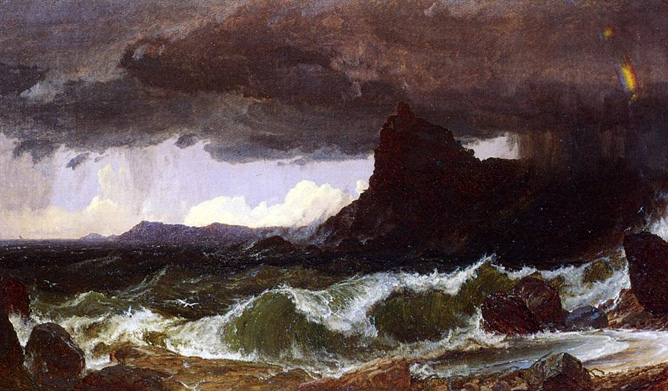
Evening at Paestum: 1856
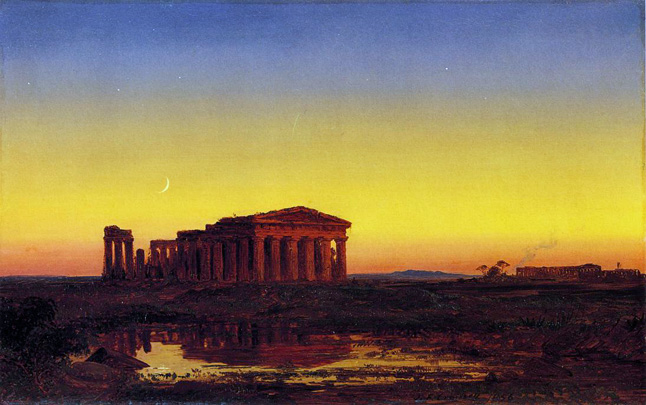
Pool in the Woods: 1855

Richmond Hill and the Thames, London: 1861
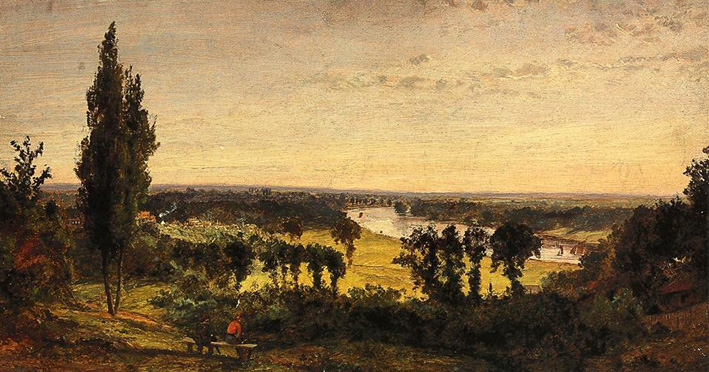
Richmond Hill in 1862

Spring, Chenango Valley: 1859
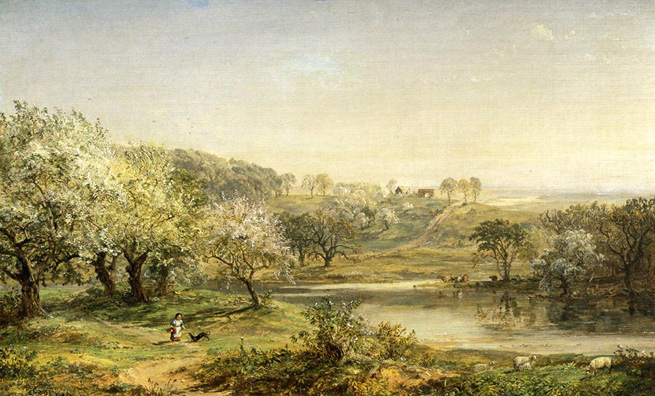
Summer, Noonday on the Arno: 1860
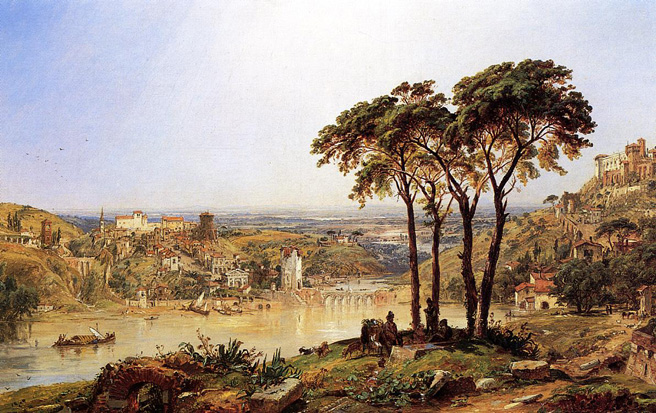
The Church at Stoke Poges: 1864
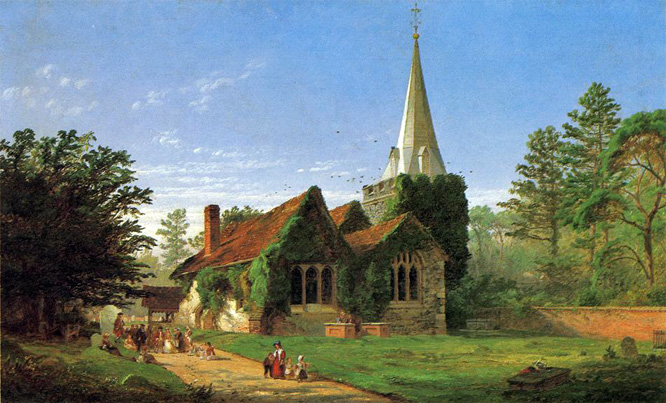
Banks of the River: 1861
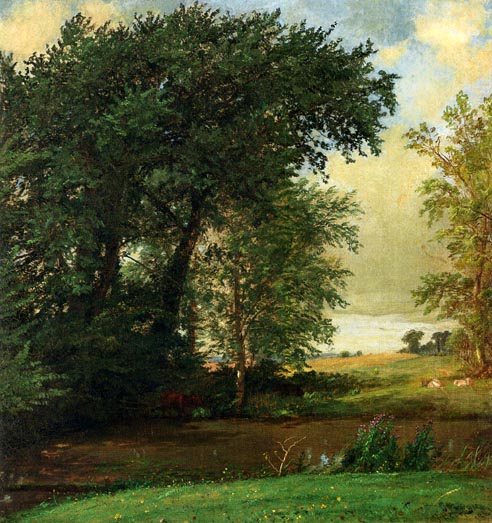
The Cottage of the Dairyman's Daughter: 1859
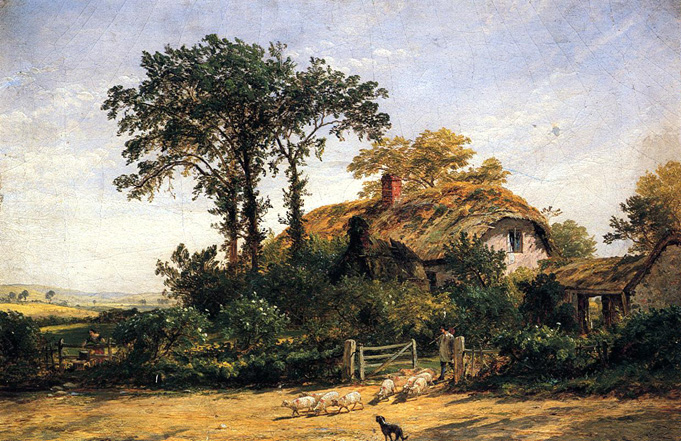
The Serptentine, Hyde Park, London: 1858
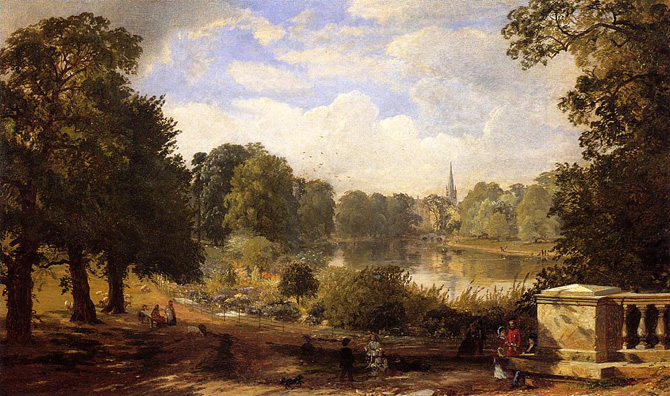
View of Stifford: 1858
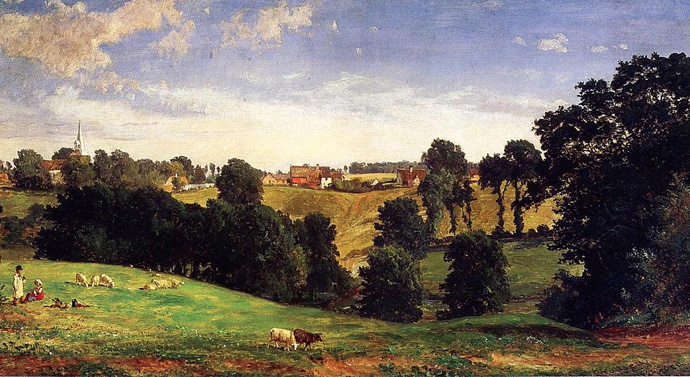
Warwick Castle, England: 1857
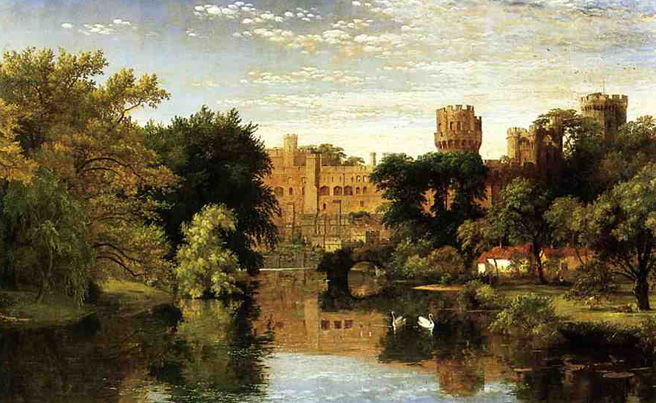
Winter in Switzerland: 1860
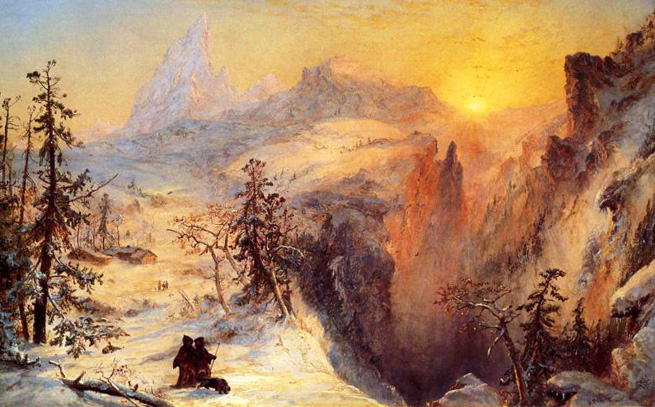
Winter in Switzerland: 1861
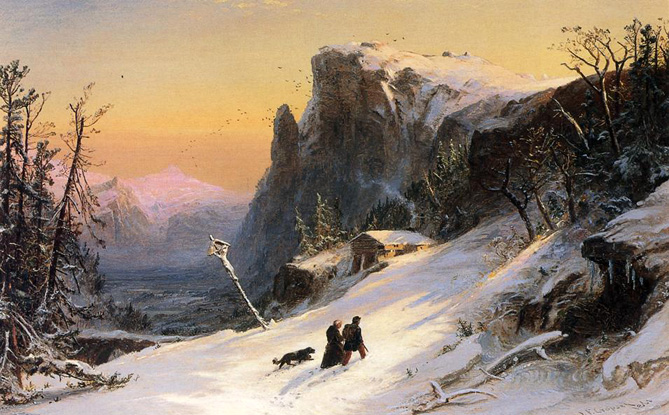
Returning home, he opened a studio in New York and specialized in autumnal landscape paintings of the northeastern United States, often idealized and with vivid colors. Cropsey co-founded, with ten fellow artists, the American Society of Painters in Water Colors in 1866. He resided in the City until 1885, when he removed to Hastings-on-Hudson.
Cropsey's home and studio, Ever Rest, in Hastings-on-Hudson, New York as well as the largest permanent collection of Cropsey's work are open for tours by the Newington-Cropsey Foundation.
Jasper Cropsey died in anonymity but was rediscovered by galleries and collectors in the 1960's. Today, Cropsey's paintings are found in most major American museums, including the National Gallery of Art, the Metropolitan Museum of Art, the Los Angeles County Museum of Art, the Detroit Institute of Arts, the Timken Museum of Art in San Diego, the Honolulu Academy of Arts, the Fine Arts Museums of San Francisco, the Denver Art Museum, and the Museum of Fine Arts, Boston. Works by Cropsey also hang in the White House.
Cropsey and his wife Maria are buried in Sleepy Hollow Cemetery in Sleepy Hollow, New York.
Hudson River School
Cropsey's interest in architecture continued throughout his life and was a strong influence in his painting, most evident in his precise arrangement and outline of forms. But Cropsey was best known for his lavish use of color and, as a first-generation member from the Hudson River School, painted autumn landscapes that startled viewers with their boldness and brilliance. As an artist, he believed landscapes were the highest art form and that nature was a direct manifestation of God. He also felt a patriotic affiliation with nature and saw his paintings as depicting the rugged and unspoiled qualities of America.
Some of his works include "Jedburgh Abbey"; "Pontaine Marshes" (1847); "Backwoods of America" (1857); "Richmond Hill" (1862); "Indian Summer" (1866); "Greenwood Lake" (1870); "Lake Nemi in Italy" (1879); "Old Church at Arreton, Isle of Wight" (1880); "Ramapo Valley" (1881); "Autumn on the Hudson" (1882): "Wawayanda Valley" (1883); "Spring-time in England" (1884); "October in Ramapo Valley" (1885); "Autumn on Lake George," and "A Showery Day" (1886).
Quoted From: Jasper Francis Cropsey - Wikipedia
Source: The Athenaeum - Selected Artwork of Jasper Francis Cropsey
Jedburgh Abbey
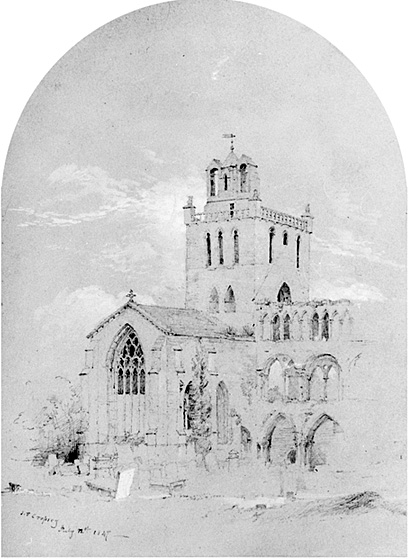
The Backwoods of America: 1857

Indian Summer: 1866
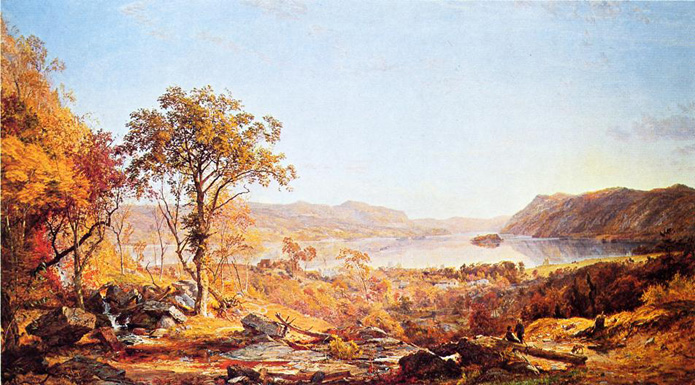
Greenwood Lake: 1870
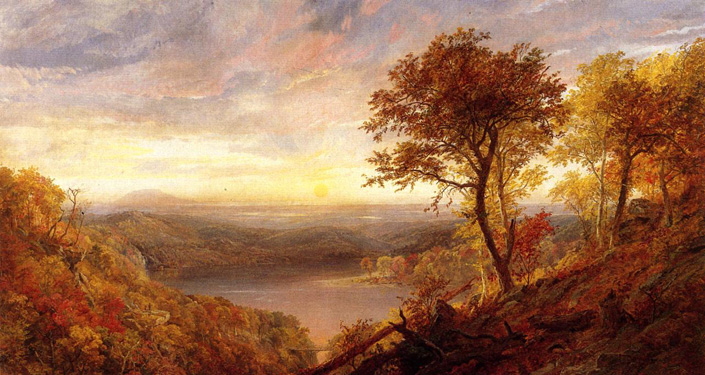
Ramapo Valley: 1881
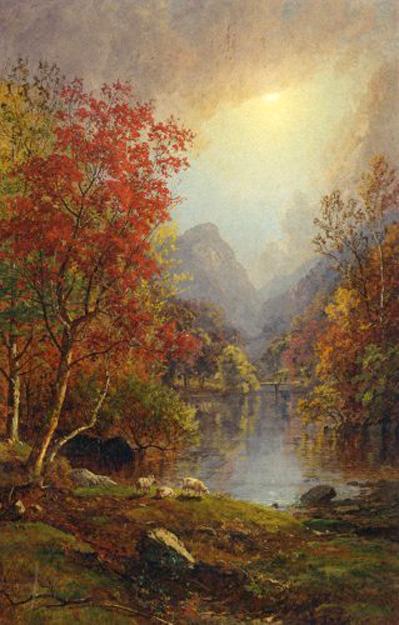
Afternoon at Greenwood Lake: 1871
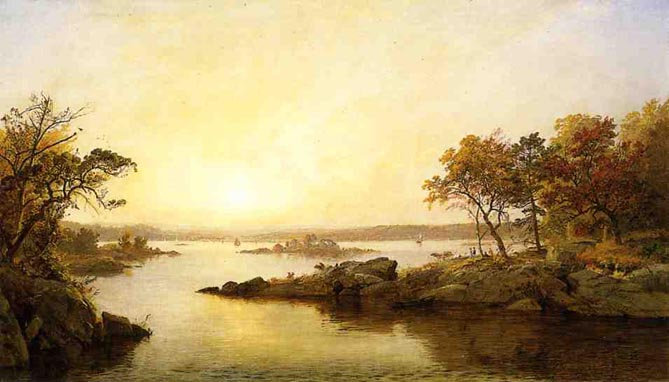
A Bend in the River: 1892
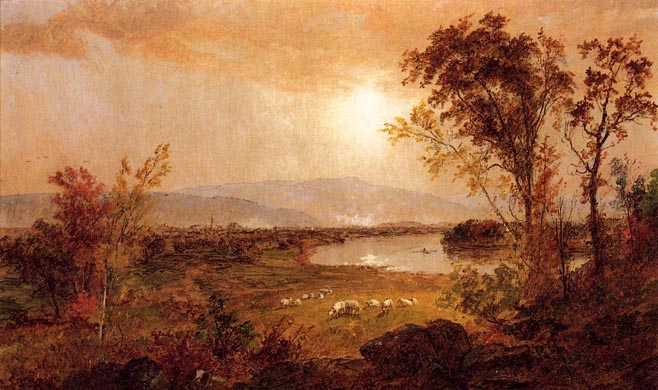
A Cabin on Greenwood Lake: 1879
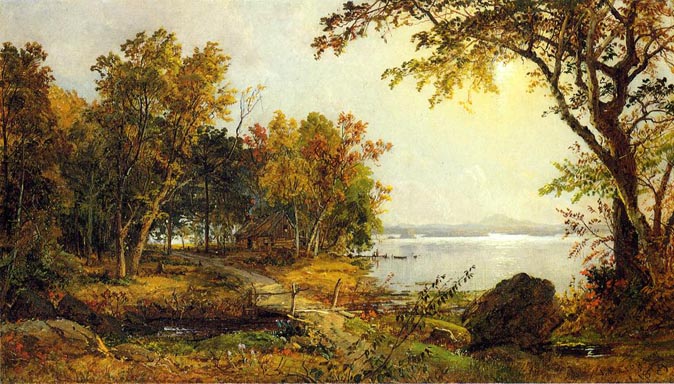
A Study at Long Beach: 1882
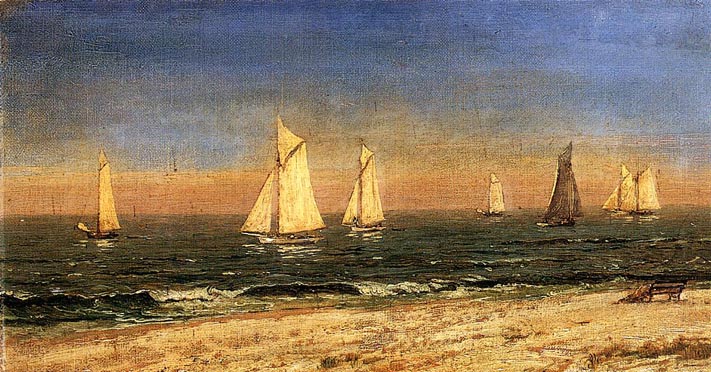
A View Upstream: 1873
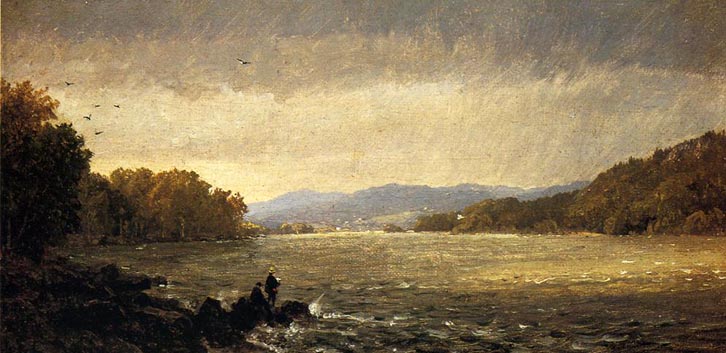
Along the Hudson: 1891
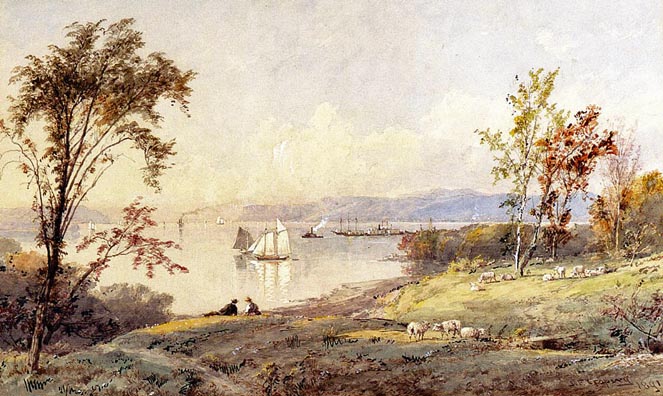
Along the River: 1871

An Indian Summer Morning in the White Mountains: 1857
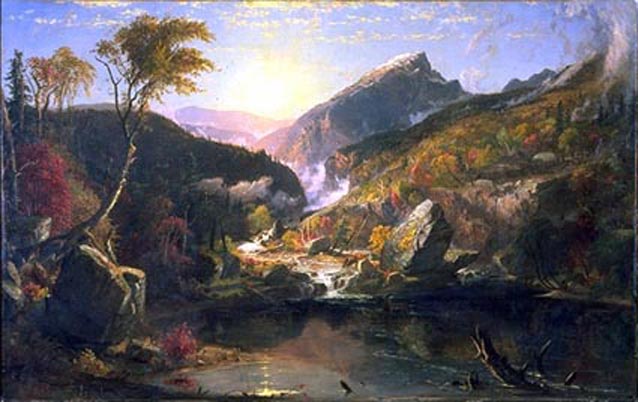
The painting An Indian Summer Morning in the White Mountains established Jasper Cropsey's reputation in the English-speaking art community and was his rehearsal for what would be the greatest success of his career. It was made in England, where Cropsey had settled in 1856, and, although probably based on sketches done on an earlier tour of the White Mountains, it was clearly a studio picture, a composite of several sites. Cropsey first displayed the painting at the spring 1857 exhibition of the Royal Academy of Arts in London; in the catalogue, the picture's description was accompanied by lines from Henry Wadsworth Longfellow's poem Evangeline.
("Filled was the air with a dreamy, magical light…")
The work was the English public's first exposure to Cropsey's autumnal palette (which critic John Ruskin at first regarded with suspicion but then came to praise for its "radiant truth"). It was also one of the first large-scale, dramatic views of the American wilderness to be shown abroad, and the British were enthralled. Critics called Cropsey an "excellent American painter" and hailed the picture's brilliant color, crisp detail, and especially the water, which was seen as particularly skillfully rendered. J.S. Morgan, the expatriate financier and collector, bought the painting a few months later for one thousand dollars, the highest price Cropsey had yet received. This success emboldened the artist to paint another wilderness view, similarly composed and colored but bucolic rather than wild, and to present it not in a gallery but as a "Great Picture" in his own studio. Autumn-On the Hudson River (1860, National Gallery of Art, Washington, DC) enjoyed an extraordinary reception, earning Cropsey a space in the art section of the prestigious London International Exhibition of 1862 and an audience with Queen Victoria.
In An Indian Summer Morning in the White Mountains, Cropsey depicts the White Mountains as a primeval paradise. The rising sun illuminates a varied prospect: there is a snow-capped, craggy peak, rolling hills ablaze with autumn hues, and a briskly running mountain stream emptying into a deep, still pool that reflects the shapes and colors of the surrounding landscape. There is no sign of human presence; a few deer drink placidly from the stream at right while others nestle in the grass at left. The elemental qualities of the scene are underscored by the swirling mists and the deep shadows cast by the low sun: this is an untouched, wild, sublime place, mysterious and, for the English public, decidedly exotic.
It may well be the public for which he intended this picture that caused Cropsey to forego the prevailing characterization of the White Mountains as a benign and pleasing setting for human activity. While Thomas Cole in the 1820s had shown the area as a savagely beautiful and forbidding place, the coming of the railroad to the region caused his interpretation of the White Mountains to be supplanted by a bucolic vision, popularized by John F. Kensett (1816-1872) and others. Cropsey's return to Cole's imagery, to the White Mountains as the "forest primeval," clearly meshed with his British audience's notion of the New World. His work remained extremely sought after for the rest of his stay in England, and upon his return to the United States in 1863, he found that his celebrity and the market for his pictures had preceded him.
CT
Quoted From: Currier Collections Online - "An Indian Summer Morning in the White Mountains" by Jasper Francis Cropsey
Apple Blossom Time: 1889
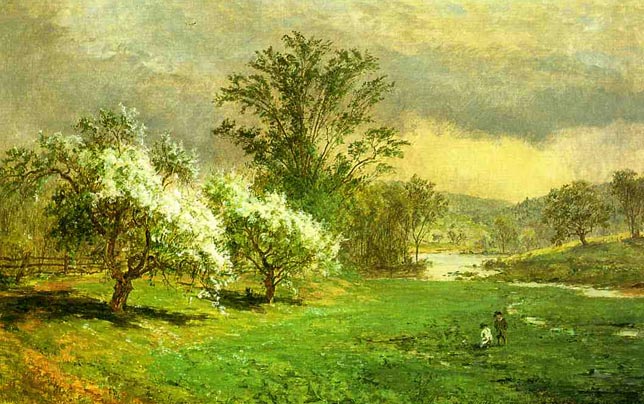
When he was only thirteen years old, Jasper Cropsey built an entirely handcrafted model of a house and entered it in a New York competition. Not only did he win an award at the 1837 fair of the Mechanics Institute of the City of New York, he attracted the attention of a local architect who offered him an internship with his firm. Cropsey's native artistic abilities were quickly recognized by his employers, and he was encouraged to work in watercolors and oils.
Cropsey completed his course of study and by 1843 was a practicing architect and artist. His mature painting style was influenced by two extended trips to Europe and the writings of philosophers and aestheticians such as Ralph Waldo Emerson and Sir Joshua Reynolds. By the 1850's, Cropsey began to paint what became his specialty - the New England autumn with its glorious and brilliant color. Throughout his life he continued to work in a careful, meticulous manner that no doubt derived from his early architectural training.
Quoted From: Timken Museum: Jasper Cropsey
Artist Sketching on Greenwood Lake: 1869
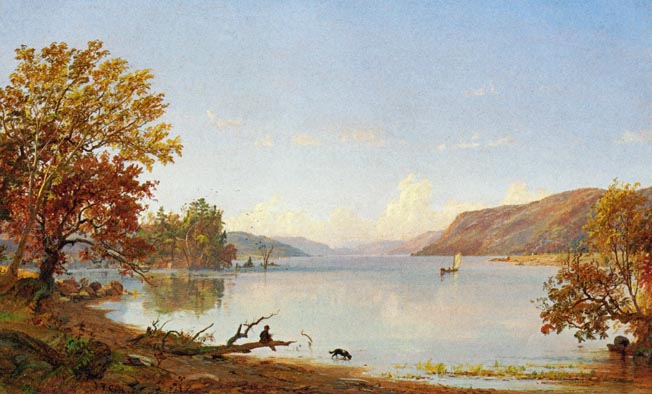
Autumn on the Hudson River: 1860

This monumental view of the Hudson River Valley was painted from memory in the artist's London studio. Cropsey adopted a high vantage point, looking southeast toward the distant Hudson River and the flank of Storm King Mountain. A small stream leads from the foreground, where three hunters and their dogs gaze into the sunlight. All along the meandering tributary there are signs of man's peaceful coexistence with nature: a small log cabin, grazing sheep, children playing on a bridge, and cows standing placidly in the water. Here, man neither conquers nor is subservient to nature; both coexist harmoniously. In fact, the landscape is depicted as a ready arena for further agricultural expansion. While autumnal scenes traditionally are associated with the transience of life, Cropsey's painting is more a celebration of American nationalism. As a critic wrote in 1860, the picture represents "not the solemn wasting away of the year, but its joyful crowning festival."
The painting created a sensation among many British viewers who had never seen such a colorful panorama of fall foliage. Indeed, because the autumn in Britain customarily is far less colorful than in the United States, the artist decided to display specimens of North American leaves alongside his painting to persuade skeptical visitors that his rendition was botanically accurate.
Quoted From: NGA - Autumn - On the Hudson River
Autumn: 1898
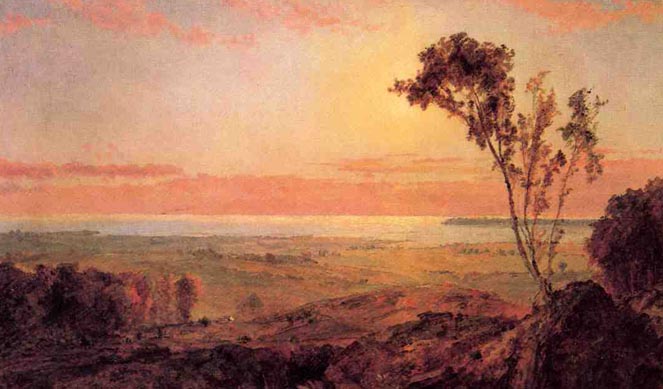
Autumn by the Lake: 1869
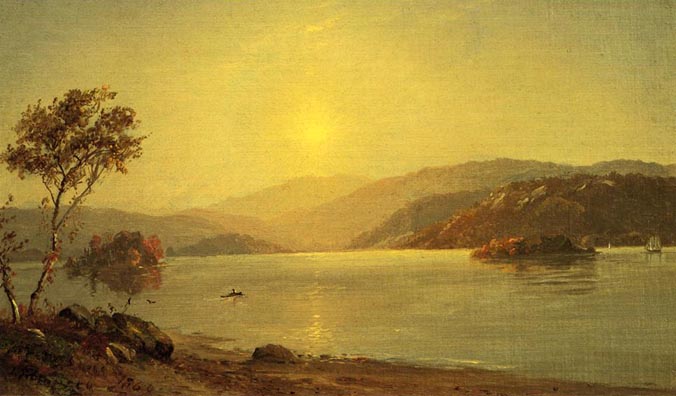
Autumn by the Lake: 1871
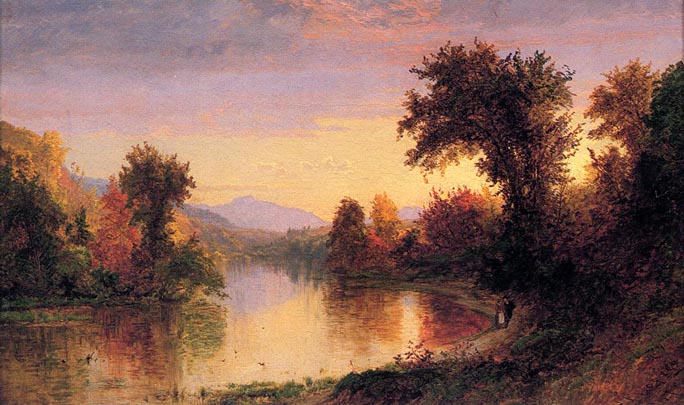
Autumn Landscape: 1877
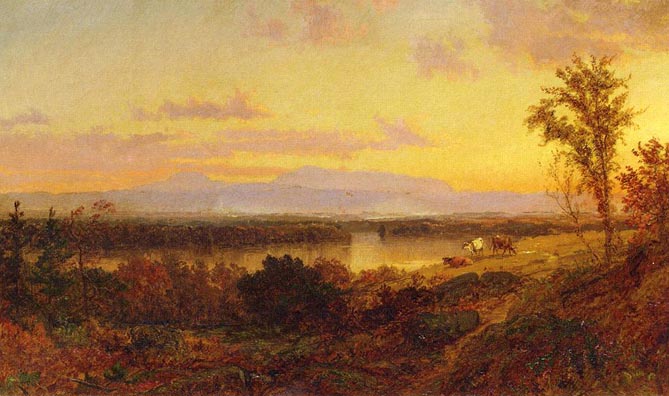
Autumn Landscape: 1879
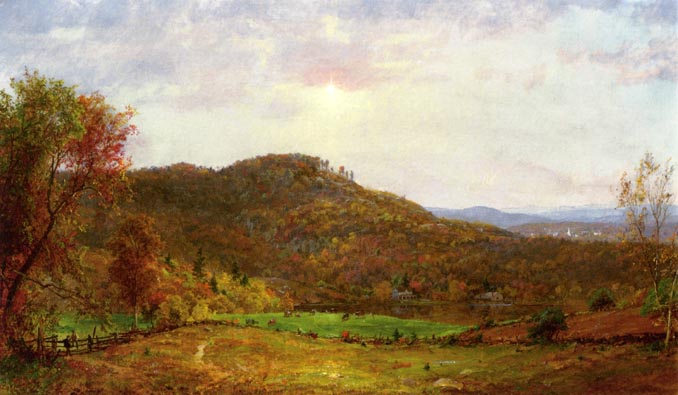
Autumn Landscape: 1886
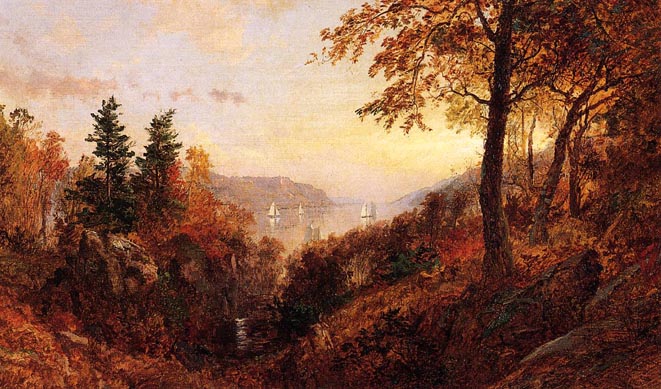
Autumn Landscape Saugerties, New York: 1886

Autumn Landscape, View of Greenwood Lake: 1875
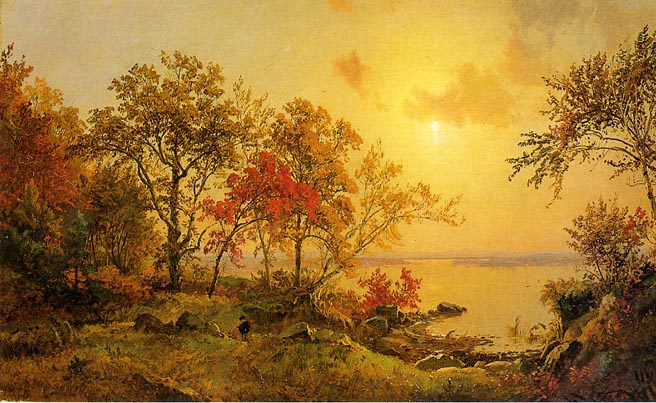
Autumn Light on the Ramapo River: 1875
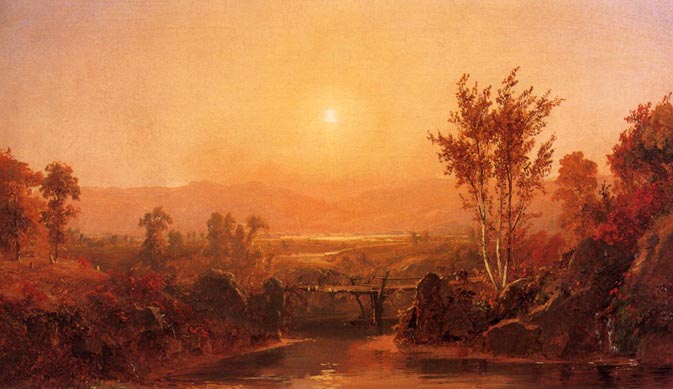
Autumn on Ramapo River, New Jersey: 1871

Autumn on the Hudson: 1884
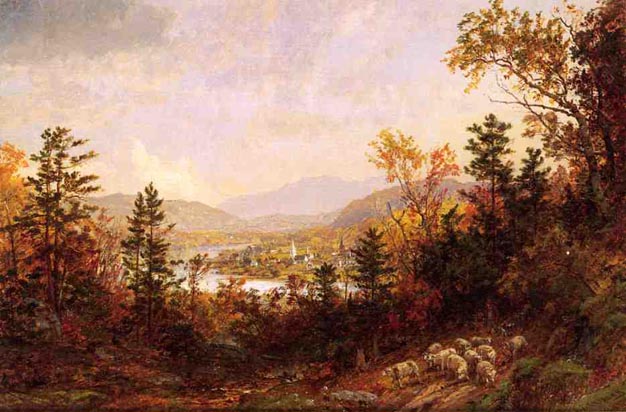
Autumn on the Susquehanna: 1859
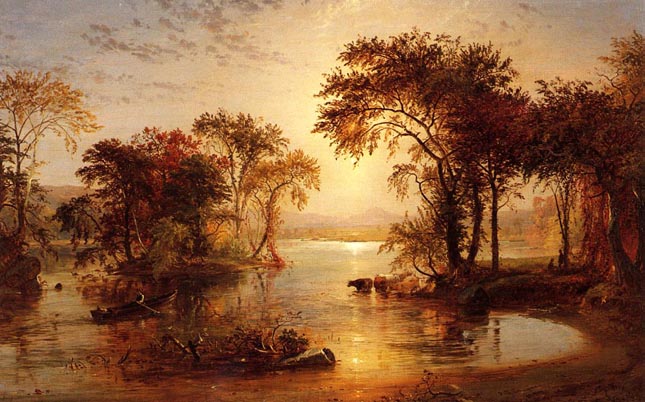
Autumn Pastoral: 1889
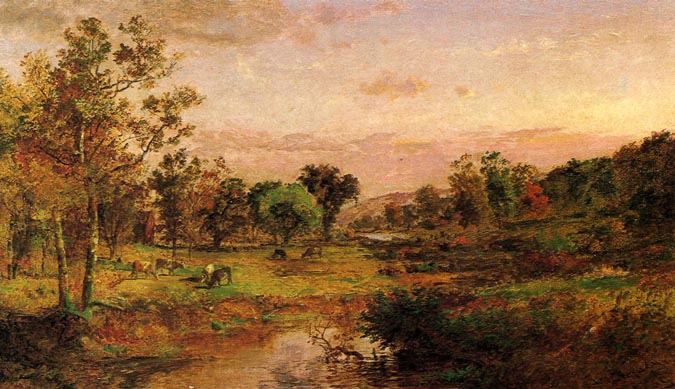
Autumn River Landscape: 1877
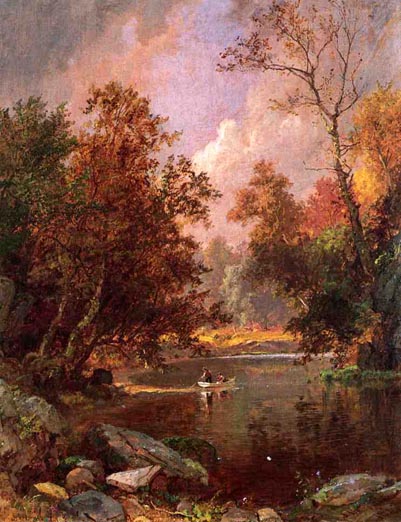
Autumn Sunset: ca 1868-75

We have a new painting by the Hudson River School artist Jasper Cropsey (1823-1900) at the gallery, entitled Autumn Sunset. Art historian Kenneth W. Maddox (who is preparing the Cropsey catalogue raisonné for publication by the Newington-Cropsey Foundation) identifies the work as among Cropsey's many views based on Greenwood Lake, in northern New Jersey, where the artist's wife's family had a home, and where Cropsey painted often from the 1840s through the 1890s. The painting can be linked with a number of images Cropsey created of this site in the early 1870s. A comparable work is Greenwood Lake, New Jersey of 1871.
Quoted From: Spanierman Gallery | An American Art Blog
Back of the Village Hastings-on-Hudson, New York: 1886
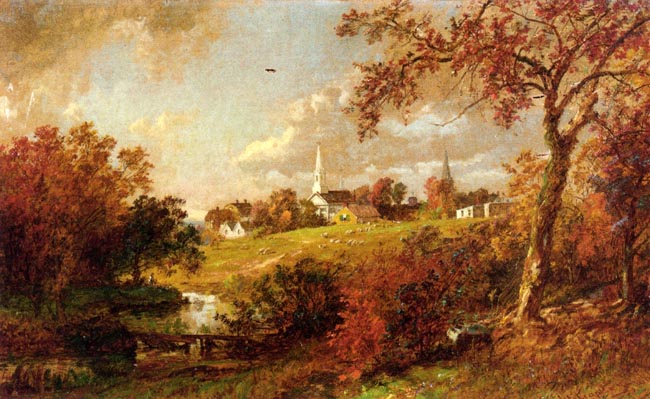
Boat Caulking on Greenwood Lake: 1852
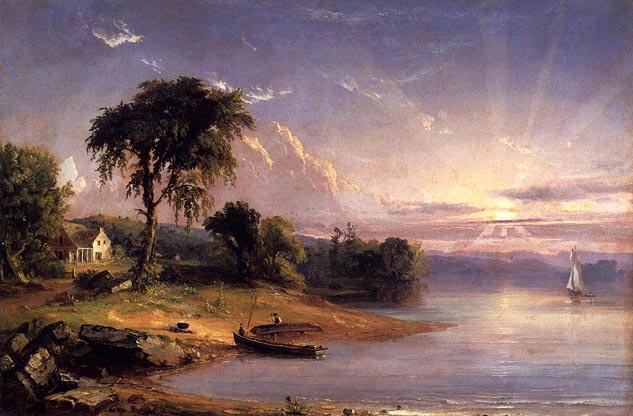
Boaters on a Lake: 1875
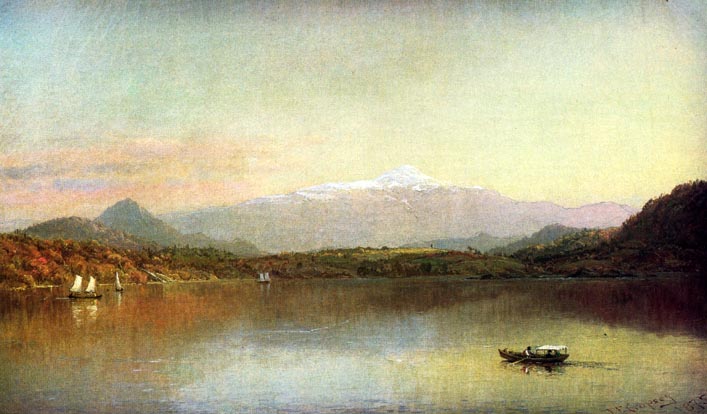
Bridge on the Wawayanda River: 1882
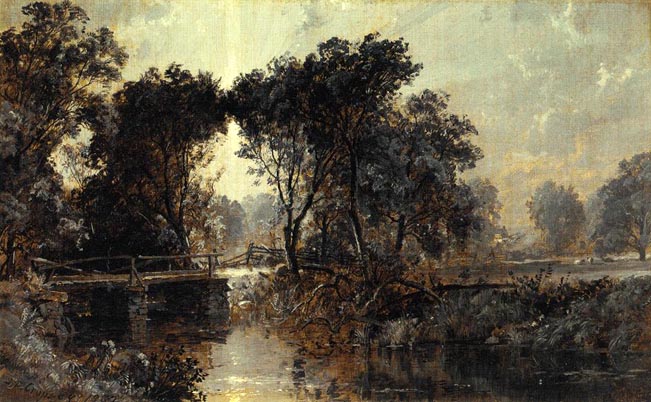
By the Lake: 1893
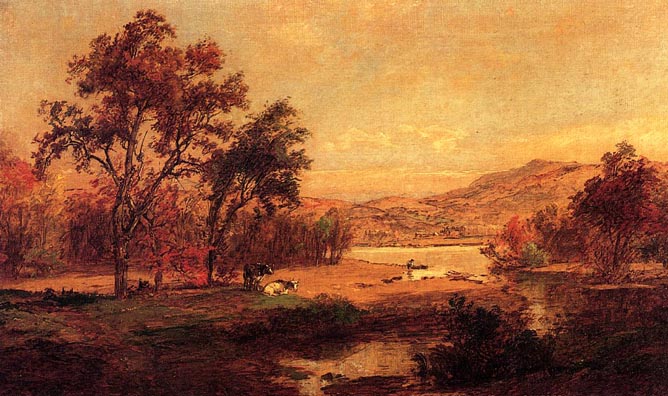
By the River: 1875
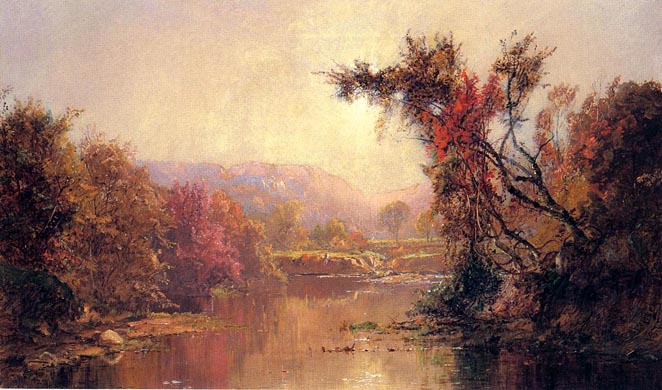
Coastal Scene: 1876

Conversation at the Fence: 1873
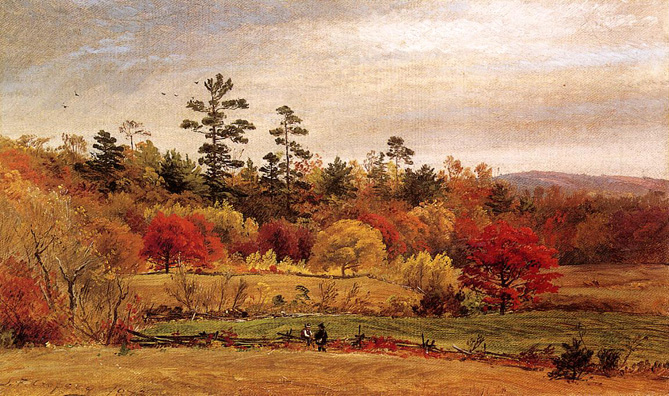
Early Snow on Mount Washington: 1891
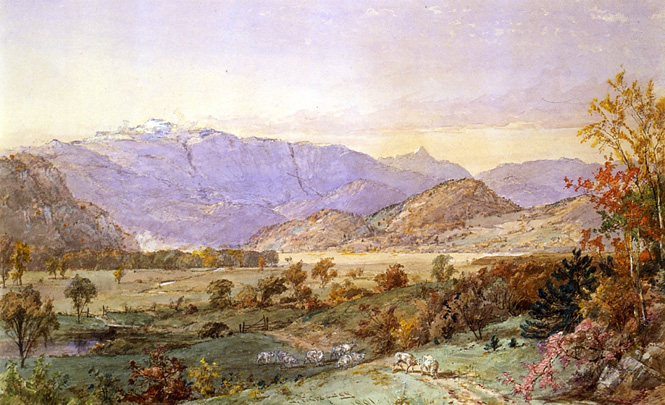
Farm Along the River: 1889
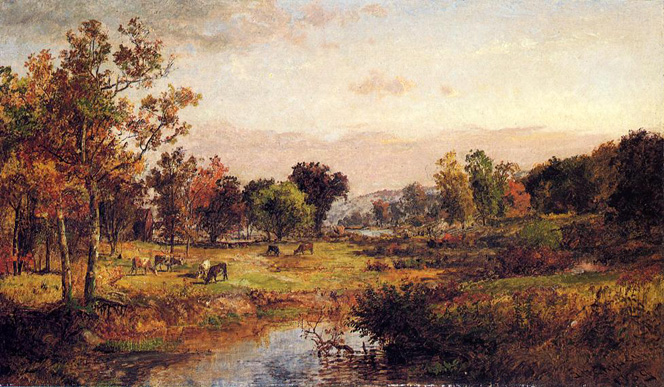
Figures on the Hudson River: 1874
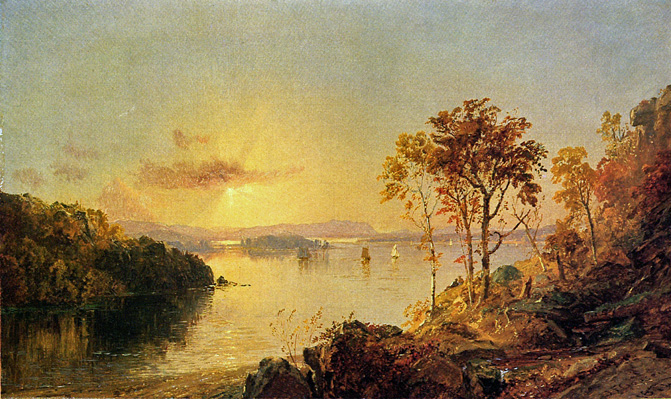
Fisherman in Autumn Landscape: 1879
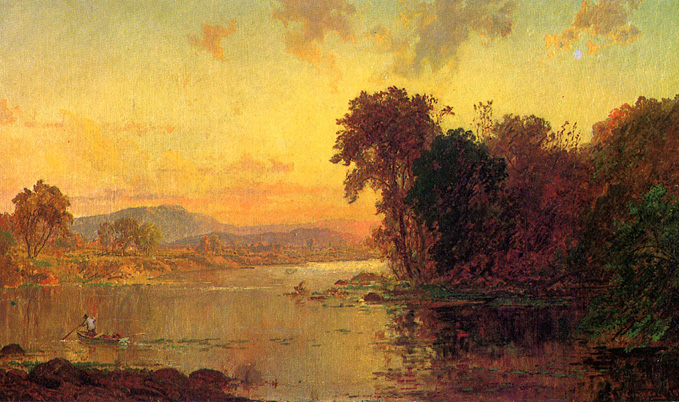
Fisherman's Hut Greenwood Lake: 1877

Fishing on a Lake: 1890
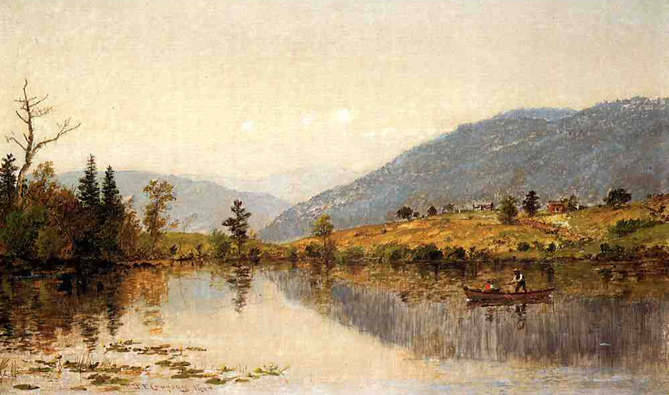
Flowering Trees: 1894
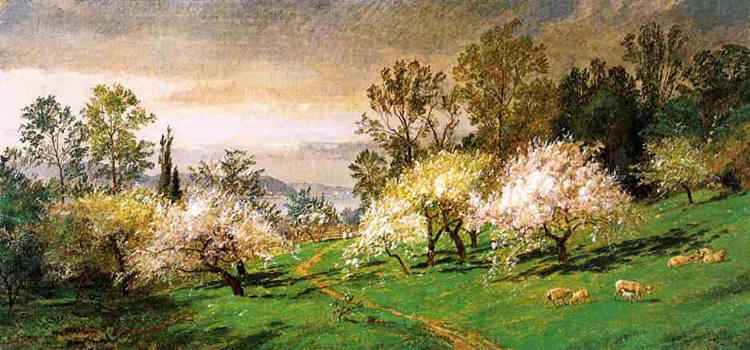
Gates of the Hudson: 1897

Greenwood Lake: 1865
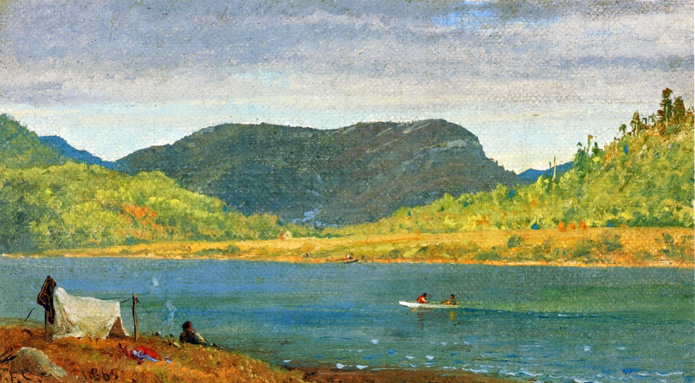
Greenwood Lake: 1875
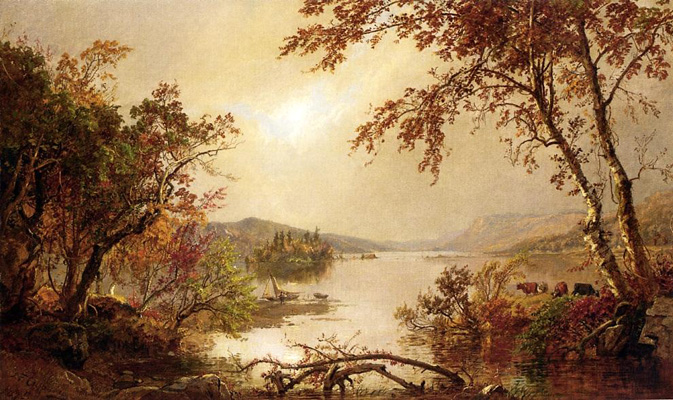
Greenwood Lake in September: 1891
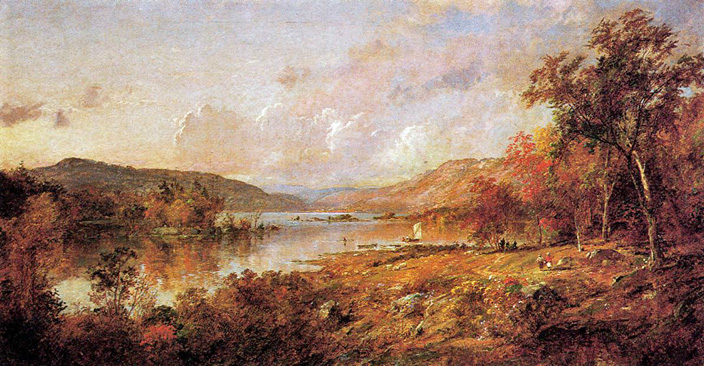
Greenwood Lake, New Jersey: 1897
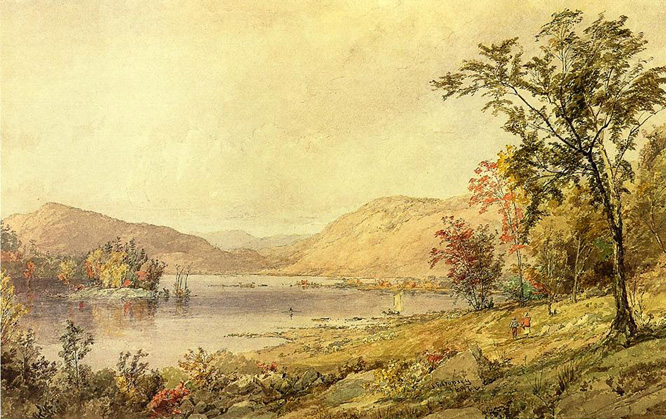
Greenwood Lake, New Jersey, in September 1893
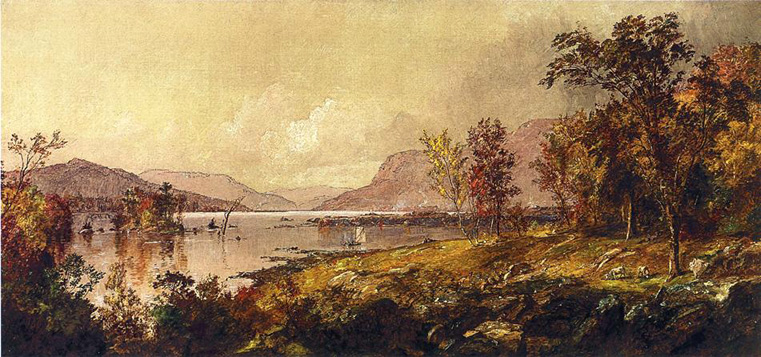
Hackensack Meadows: 1890
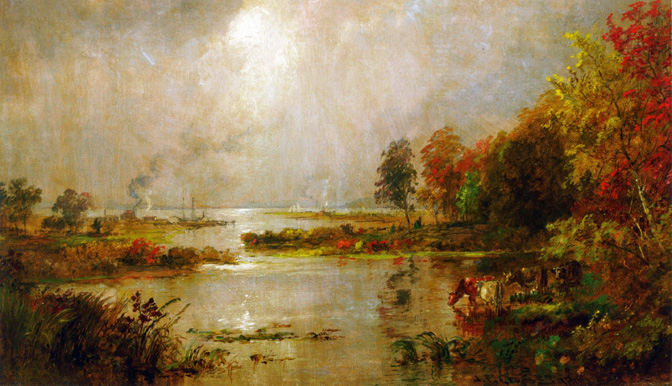
Hackensack Meadows in the Autumn: 1894

Hazy Afternoon, Autumn: 1873
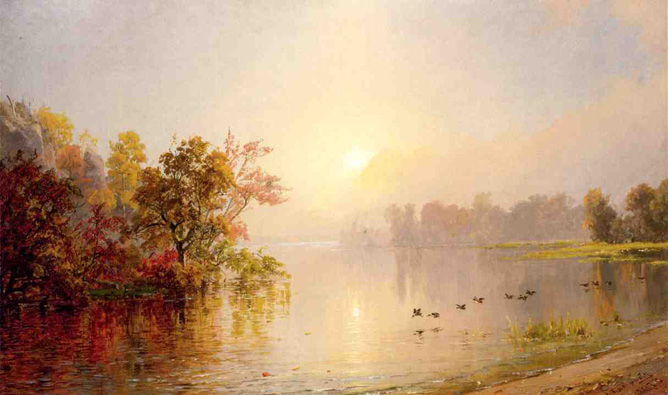
Headwaters of the Hudson: ca 1878
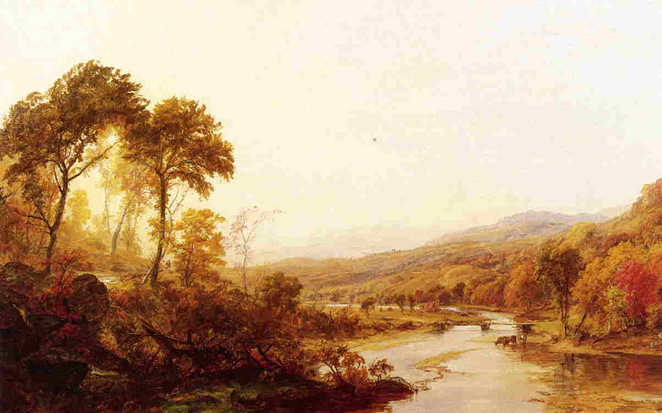
Hudson River View, Summer: 1872
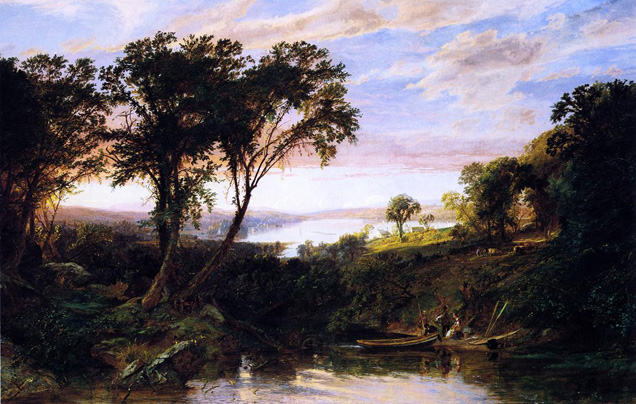
Ideal Landscape - Homage to Thomas Cole: 1850
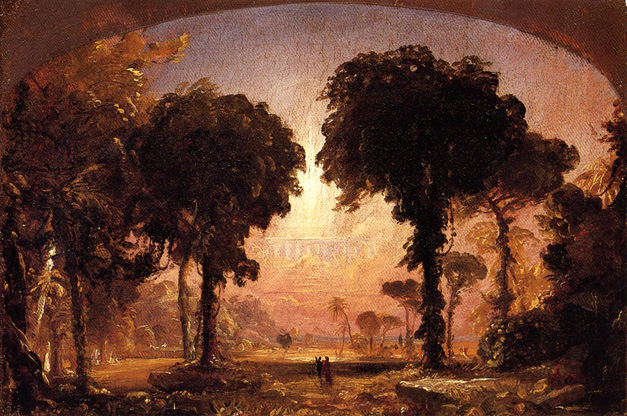
In the Highlands of the Hudson: 1898
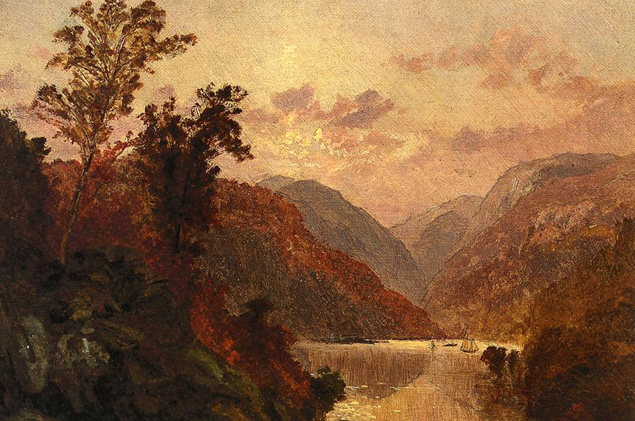
In the White Mountains: 1862

Italian Landscape: 1875
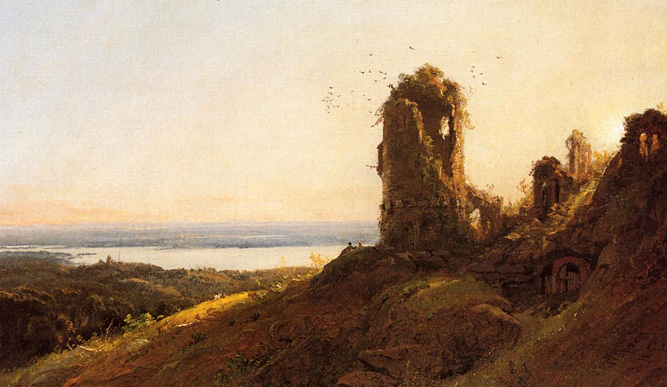
Lake George 'Sun Behind a Cloud': 1866

Lake George, New York: 1892
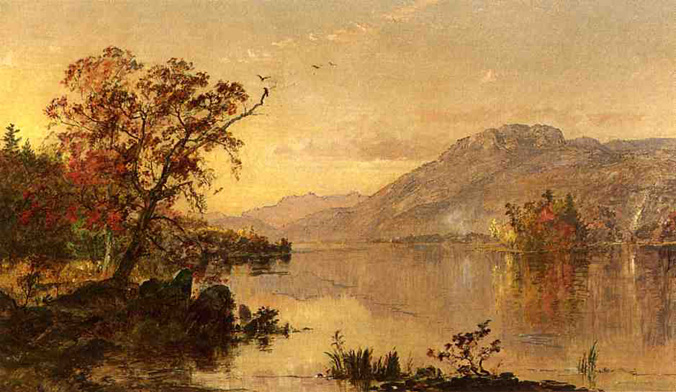
Lake near Mount Chocorua: 1875
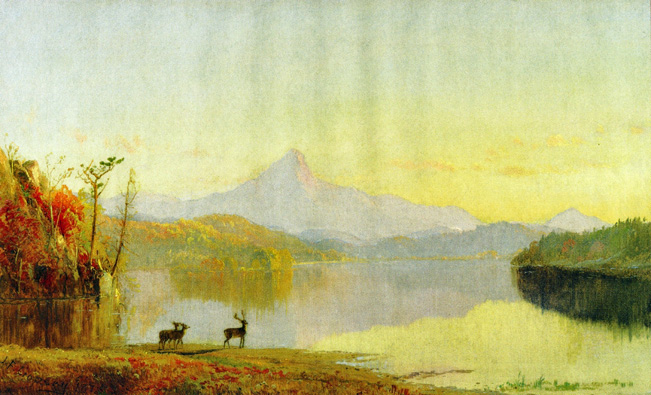
Lake Scene Mount Chocorua: 1875

Landscape: ca 1870-89
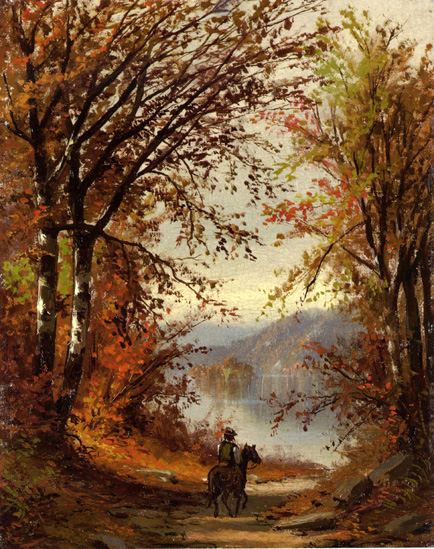
Looking North on the Hudson: 1890

Looking out to Sea: 1873
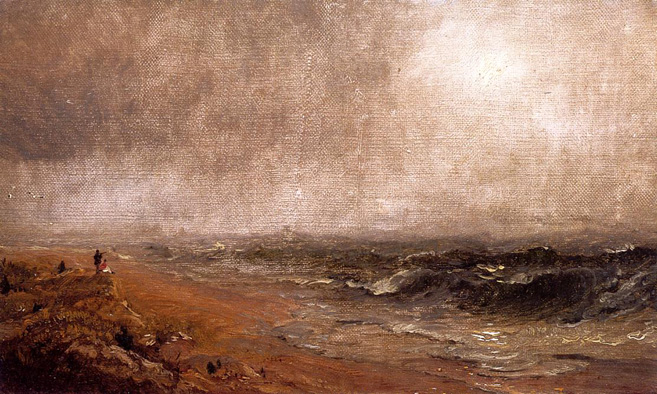
Moonlit Seascape: 1870

Mounts Adam and Eve: 1872
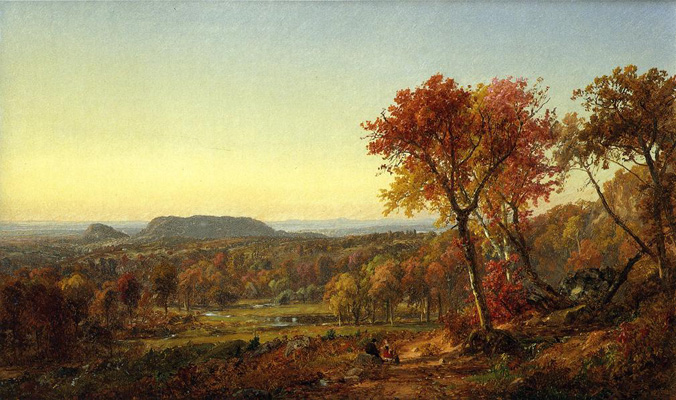
Niagara Falls with View of Clifton House: 1852
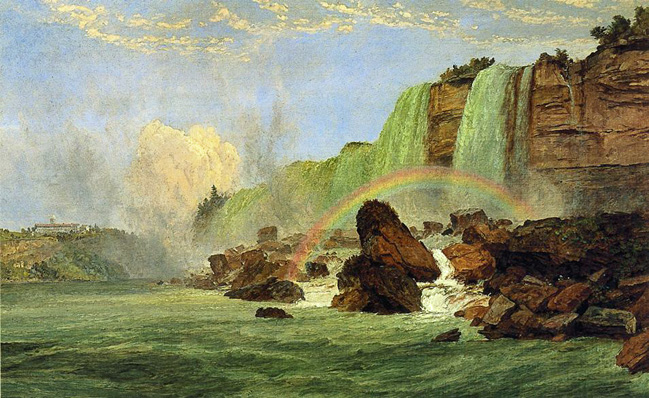
On the Hudson near West Point: 1877
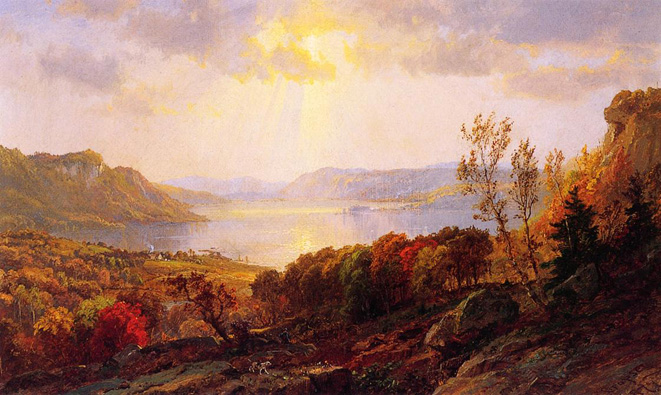
On the Ramapo River: 1888
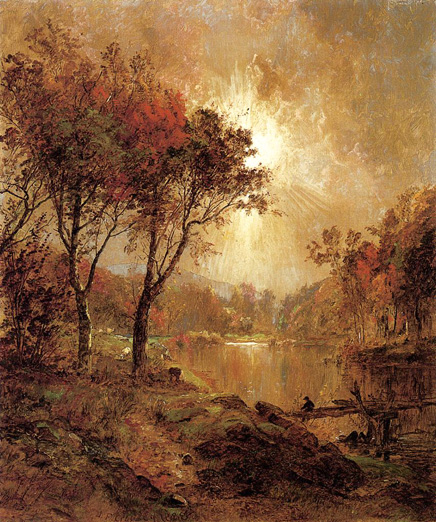
On the Saw Mill River: 1891

On the Susquahana River: 1880
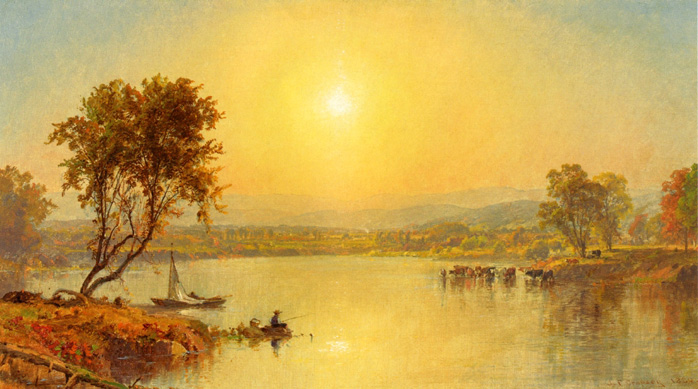
On the Susquehanna: 1877
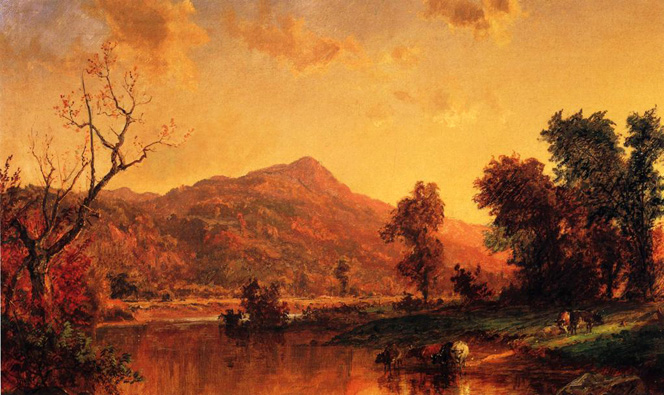
Overlooking the Bay of Naples: 1883
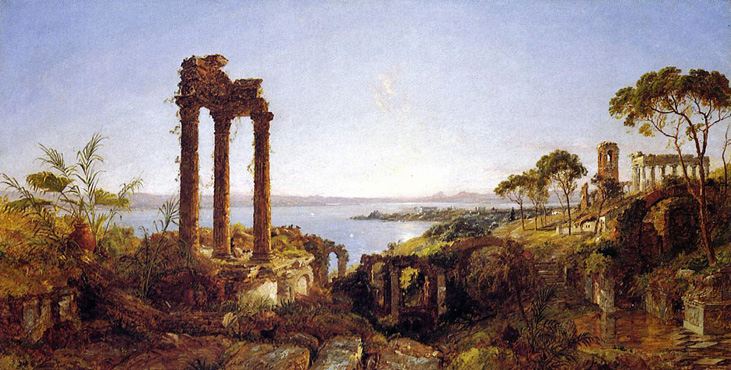
Palisades Opposite Hastings-on-Hudson: 1887
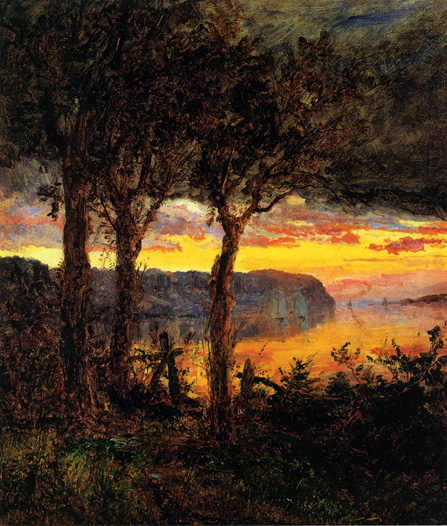
Portrait of the Painter Emile-Henri Laport
(aka A Bend in the River): Date Unknown
_Date_Unknown.jpg)
Promenade on Ring Rock: 1866
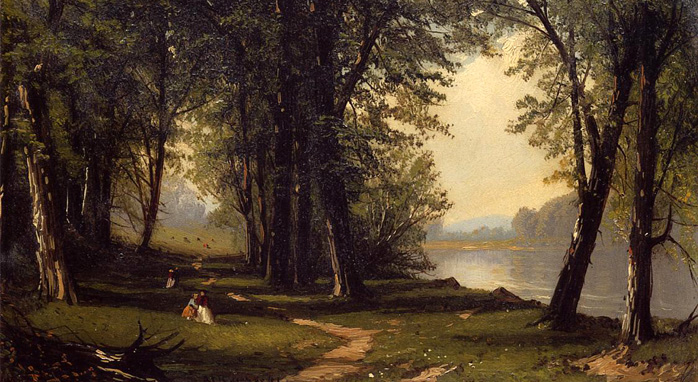
River in Autumn: 1868
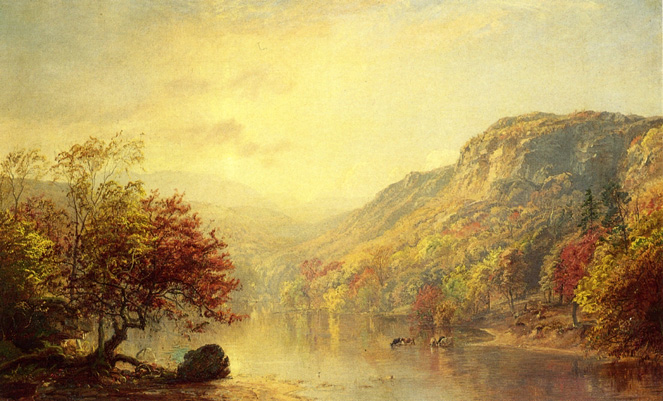
Rowing at Sunset: 1873
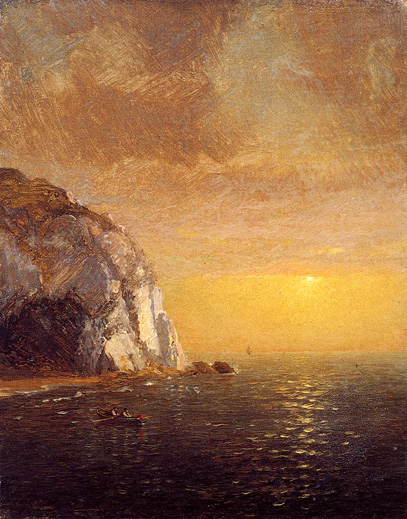
Seascape: 1882
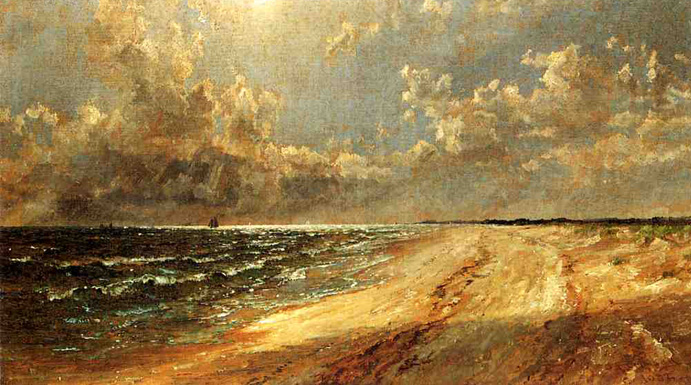
Shepherd and Flock: 1875
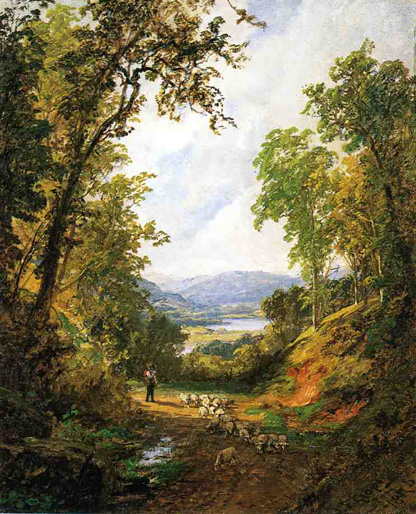
Sportsmen Nooning: 1854
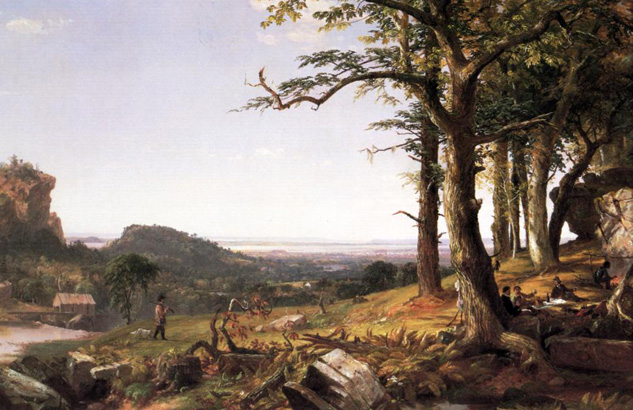
Spring, Chenango Valley: 1859

Sunset at Greenwood Lake: 1888
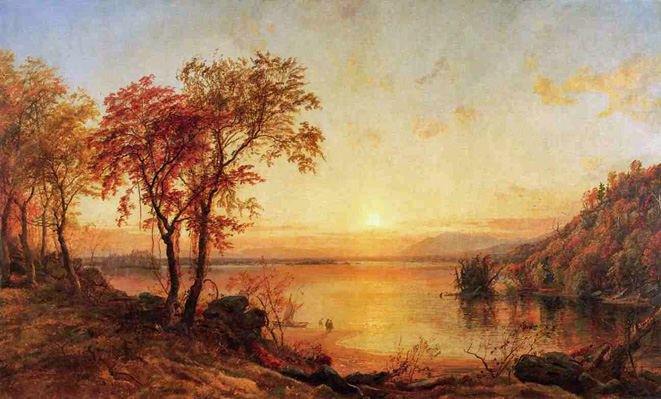
Sunset over Lake Thrasemine: 1881
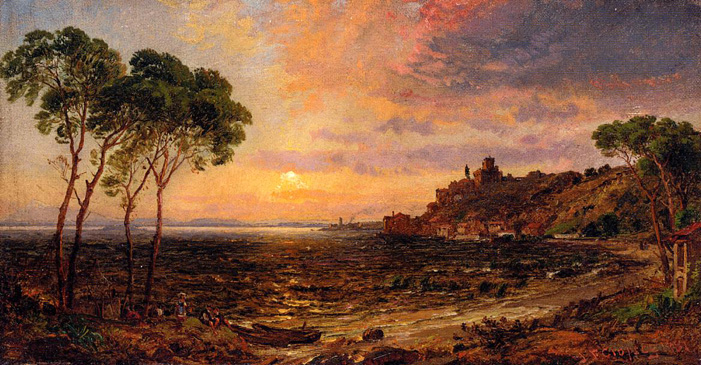
The Bay of Naples: 1894
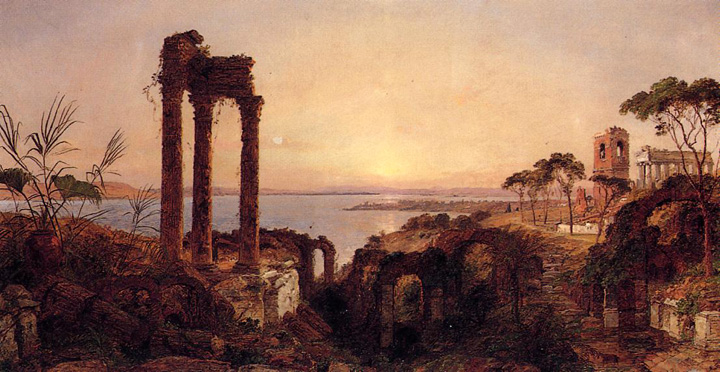
The Campagna of Rome: 1872

The Hudson at Tappan Zee: 1883
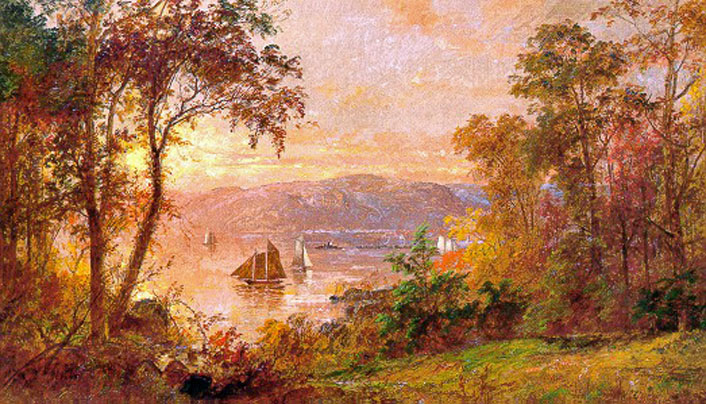
Jasper F Cropsey had painted the Hudson River since the 1850s. His Autumn-On the Hudson River (1860, National Gallery of Art) was a sensational success in London, where he lived from 1856 to 1863. It is a very large panoramic painting with such bright autumnal foliage that the painter, in order to convince his audience of the veracity of his colors, exhibited with it some genuine autumn leaves from America. After returning to America in 1863, Cropsey pursued a highly successful career painting the landscape of New York, New Jersey, Pennsylvania, and the White Mountains with occasional views of the Hudson in oil or, with growing frequency, watercolor. In 1869, his ambition and reputation prompted him to design and build Aladdin, a twenty-nine room Victorian mansion high on a hill in Warwick, New York. During the 1870's, Cropsey did not paint the Hudson as frequently as he did European subjects, panoramic views of other American valleys, mountains and lake scenes, often done with great sensitivity to water reflections and the effects of moist atmosphere. Although he exhibited three pictures in the 1876 Philadelphia Centennial Exhibition, one of which, The Old Mill (1876, The Chrysler Museum, Norfolk, Va.), set in the blazing colors of autumn, not only received favorable notice but reproductions of which remain popular today, Cropsey's fortunes had passed their peak. Debts incurred building Aladdin, the acquisition of property in New York City, other debts surviving from England, and reduced painting production due to the artist's preoccupation with building and illness finally led to such dire financial straits that Aladdin had to be sold in 1884. The Cropsey's moved to Hastings - on-Hudson, New York and into a house with a view of the river which appeared frequently in his later work.
A close examination of Sailing reveals that it is dated 1883, not 1888 as previously thought. It was thus painted when Cropsey's fortunes were at their lowest ebb, just before the mortgage sale of Aladdin. The view takes in part of the Tappan Zee, where the Hudson widens above Hastings at Tarrytown. Cropsey's frequent panoramic breadth is narrowed here by the foreground trees which flank the distant view across the river to the highlands on the west bank. Trees and brush are animated not only by bright colors but also by the vigorous lines of the drawing, which are clearly visible through the thin paint. These sketchy strokes, many of which are not part of the final design, give a somewhat unfinished, rough vitality to the work. Instead of the smoother, more finished surfaces and rounder forms of earlier pictures, one finds in the later oils flatter shapes and rougher surfaces closely related to Cropsey's increasing activity in watercolor, with its flat color areas and visible texture. Beyond the vigorous foreground and beneath a sky made more dramatic by the thickly painted pink and yellow clouds, commerce moves along the river under steam and sail. It is an autumn image by the American who is still master of that season.
WILLIAM S. TALBOT
Quoted From: JASPER F. CROPSEY 1823-1900
The Hudson River from Fort Putnam, near West Point: ca 1896
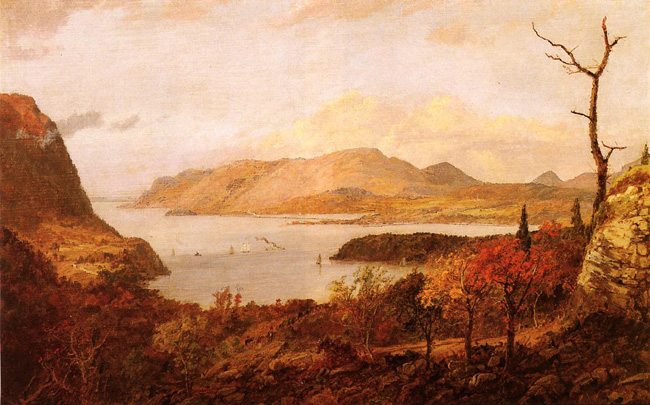
The Isle of Capri: 1848

The Lake: 1864
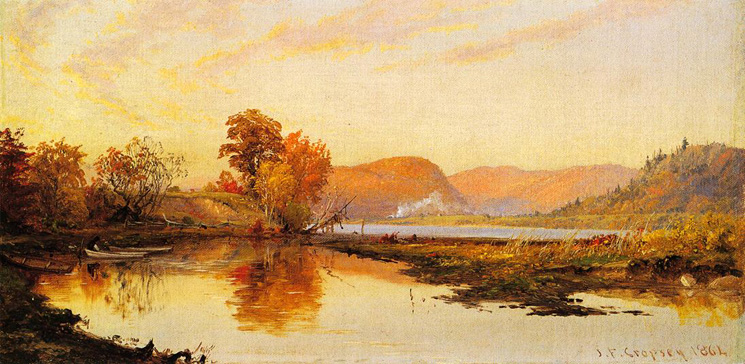
The Meeting: 1894
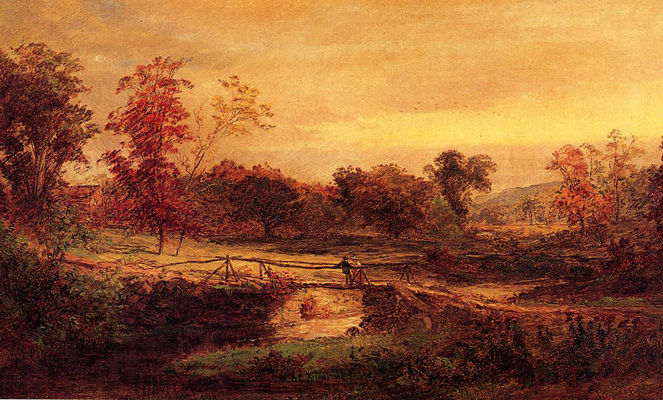
The Narrows at Lake George: 1888
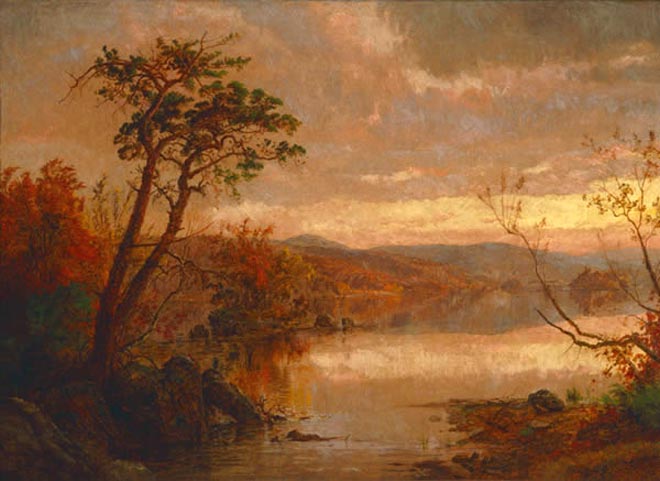
The Old Home: 1884
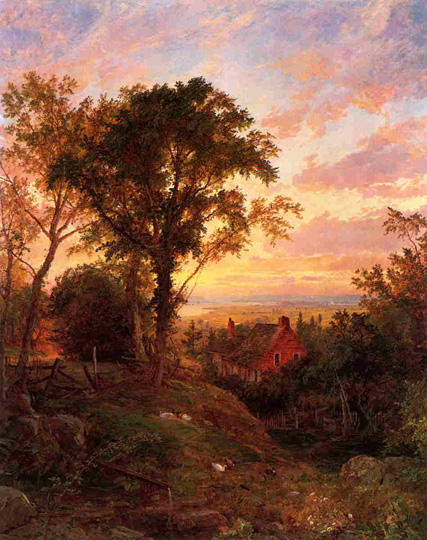
The Old Mill: 1847
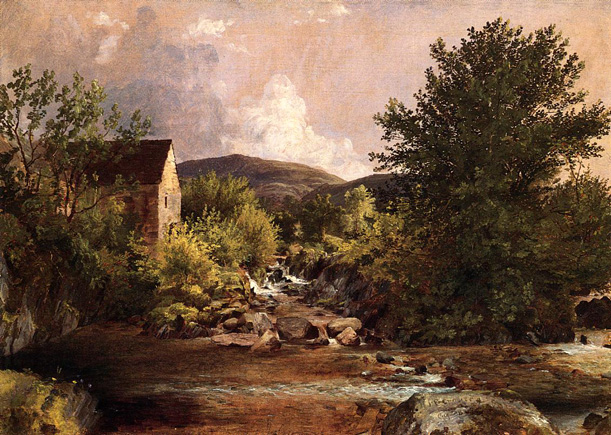
The Old Mill: 1876
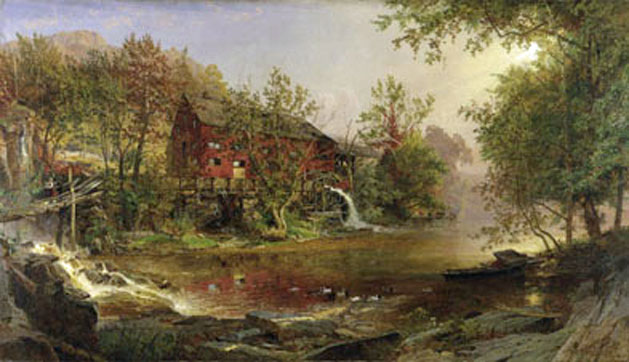
It is an oil on canvas painting of an old water mill on a river, with the river in the foreground. It's bright colors make an idyllic country scene. The setting is nostalgic: the red water mill has been abandoned in part because of Industrialism. A young couple stands on a footbridge, left side of the canvas. The painting is in a wood and gold-leafed plaster frame.
Quoted From: Chrysler Museum of Art : Collections - The Old Mill
The Pond in Springtime: 1879
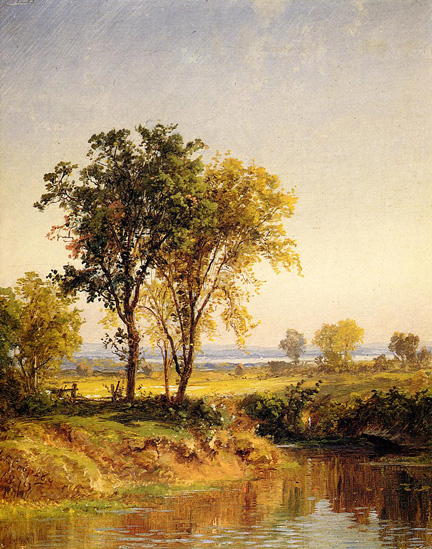
The Return Home, Landscape with Shepherd and Sheep: 1865
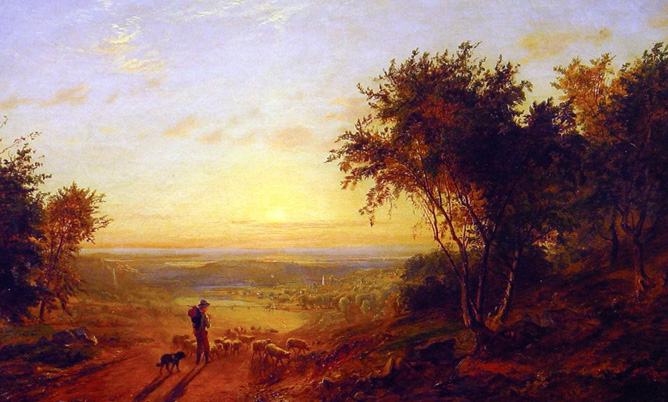
The Spirit of War: 1851
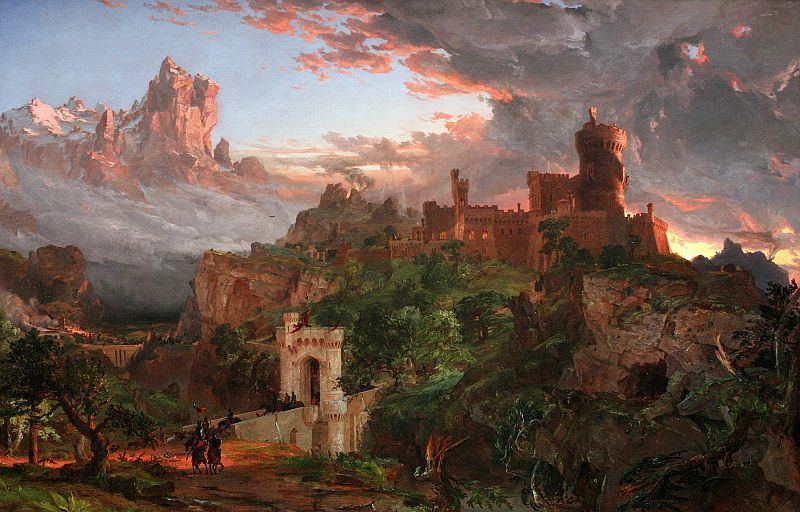
Under the Palisades in October: 1895
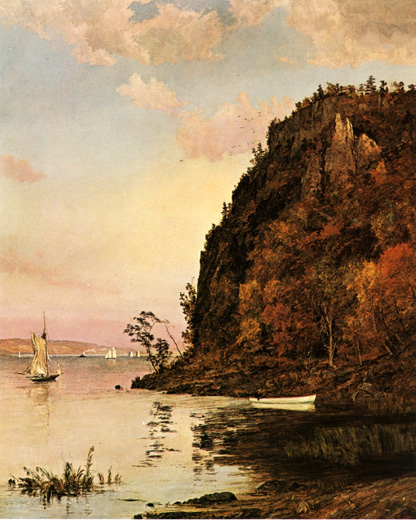
Upper Hudson: 1871
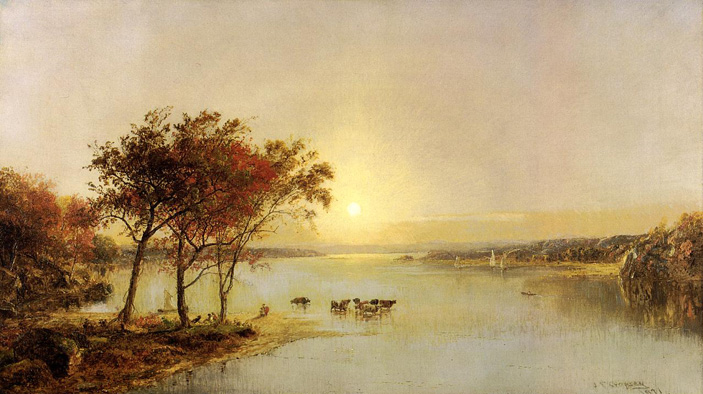
View from Hastings toward the Tappan Zee: 1887
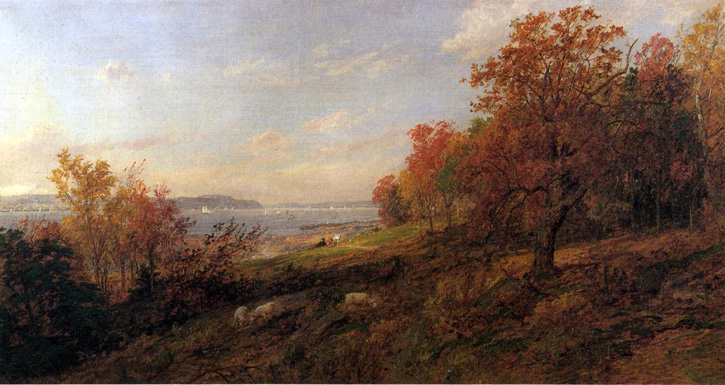
View near Sherburne, Chenango County, New York: 1853
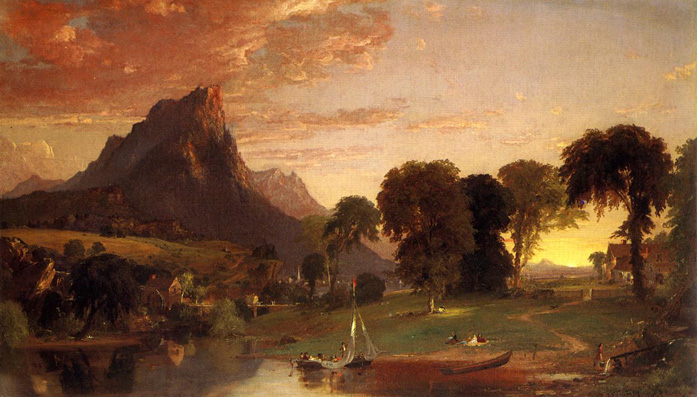
View of Greenwood Lake, New Jersey: 1845
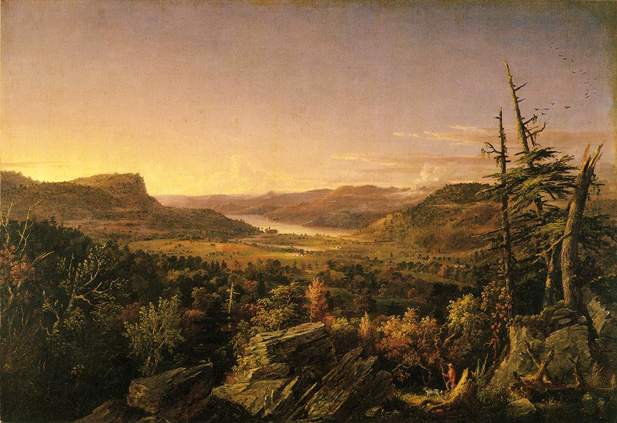
View of Stoke Poges: 1886
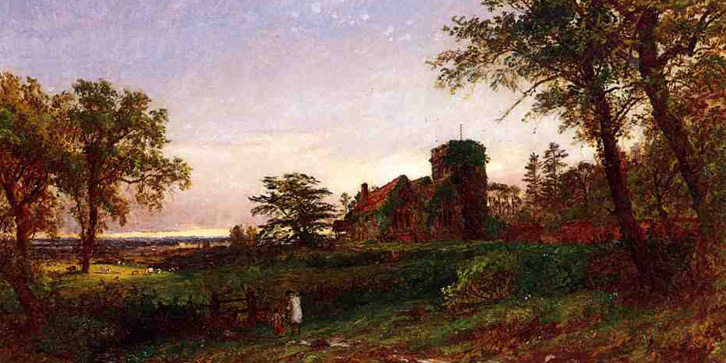
View of the Hudson: 1870

View of the Hudson: 1883
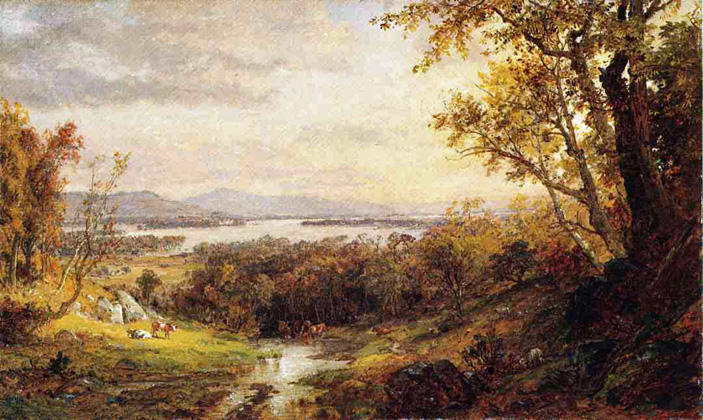
View on the Chesapeake Bay: 1893

View on the Hudson River: 1852
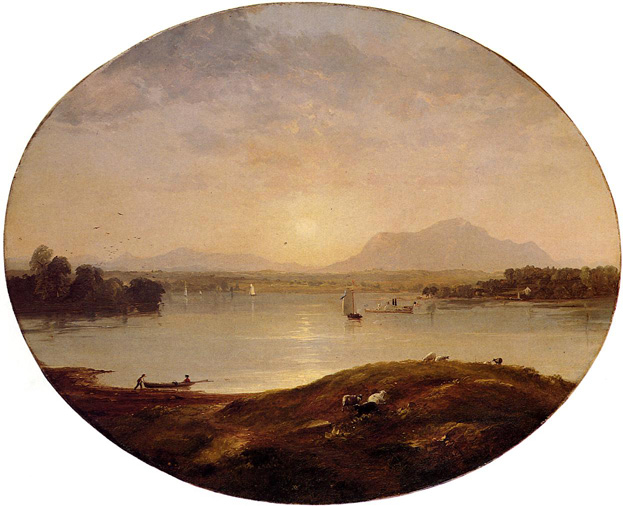
Wickham Pond and Sugar Loaf Mountain, Orange County: 1876
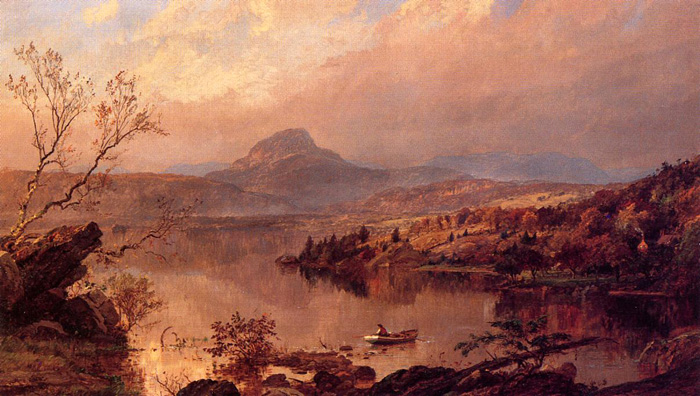
William Penn's Wedding: 1870
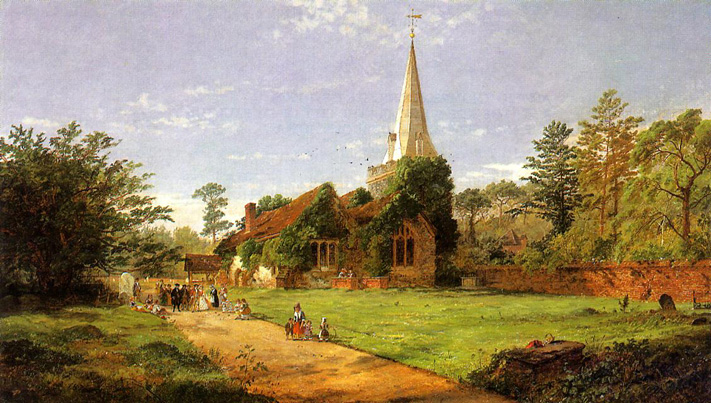
Winding River: 1870

Winter Scene, Ramapo Valley: 1853
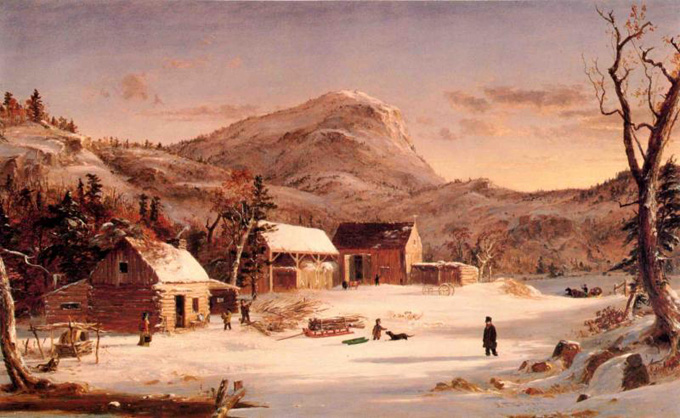
Winter on Rivensdale Road, Hastings-on-Hudson, New York: 1890

Winter Scene, North Conway, New Hampshire: 1859

Winter Wonderland: 1895
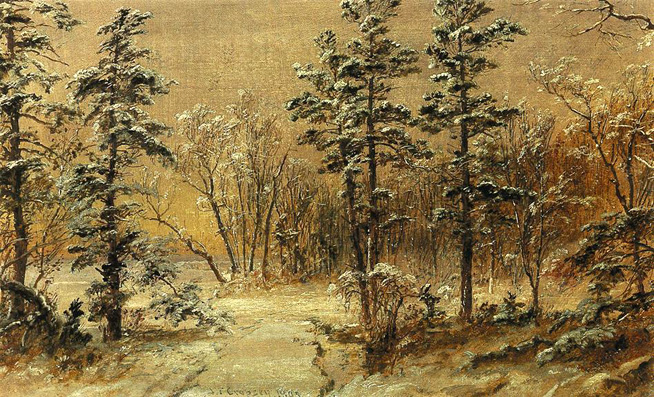
Rugged Mountain Scene (Italian): 1847
_1847.jpg)
Landscape in Early Fall: 1844

Twilight View in Sullivan County: 1845
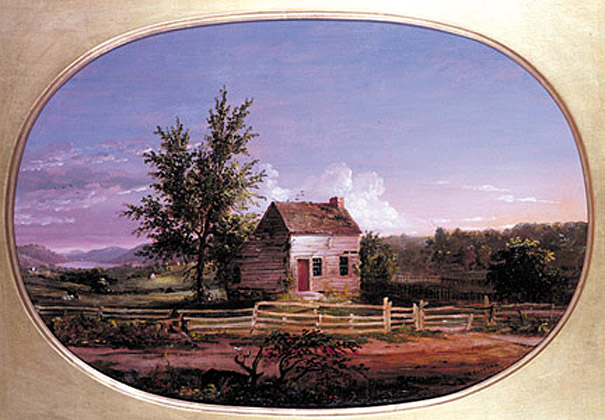
Cottage at Greenwood Lake: 1847
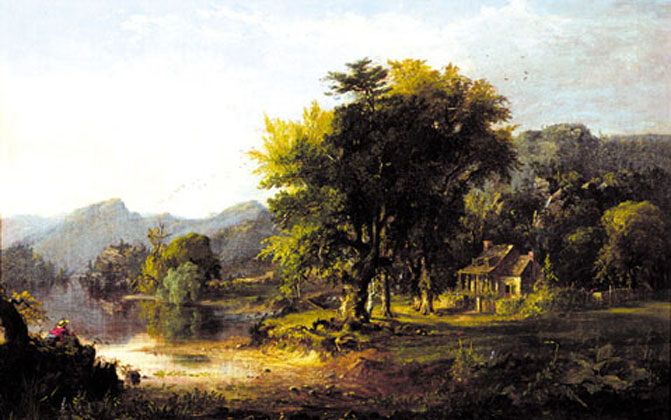
A Rocky Ledge: 1845
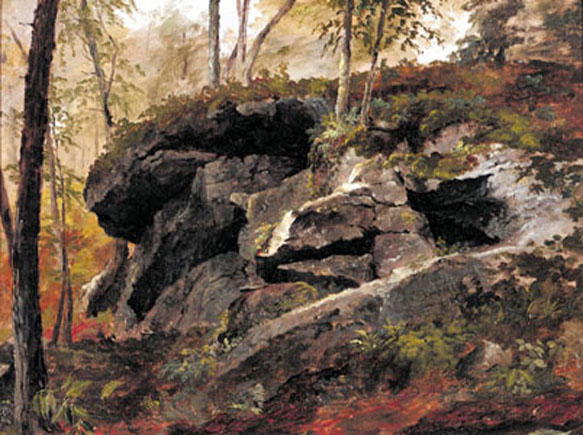
Mediterranean Sea Coast: 1855
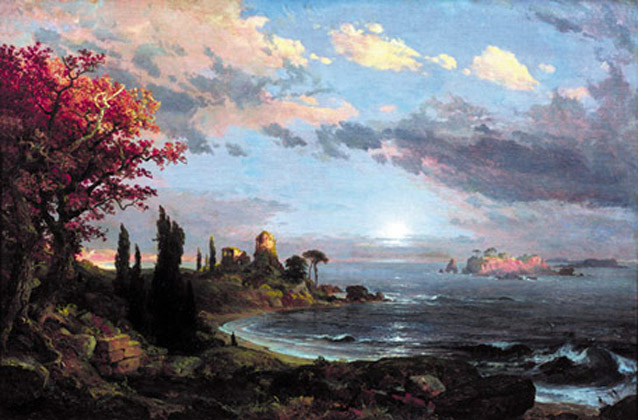
Amalfi, Italy: 1848
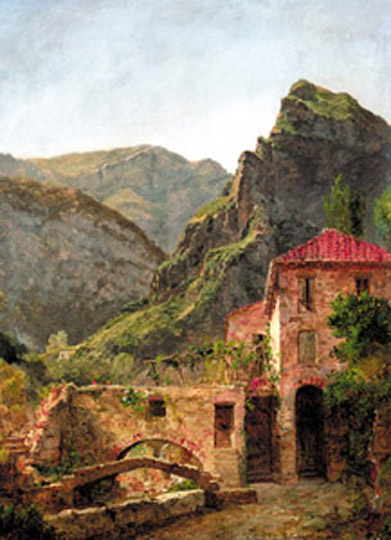
Roman Forum: 1849
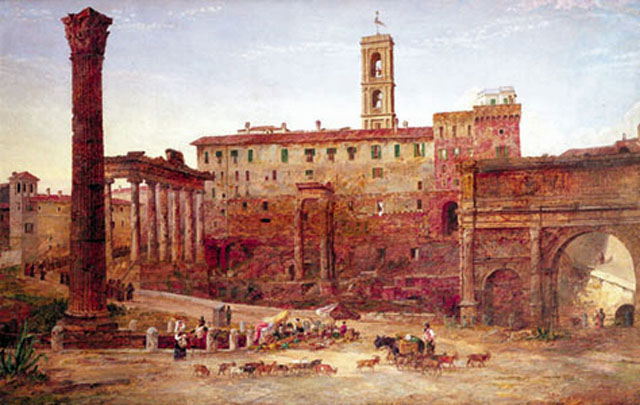
An English Roadside Scene: 1882
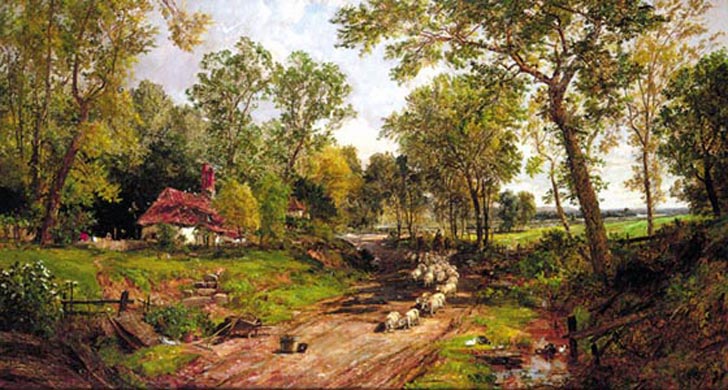
Study of Anne Hathaway's Cottage: 1859
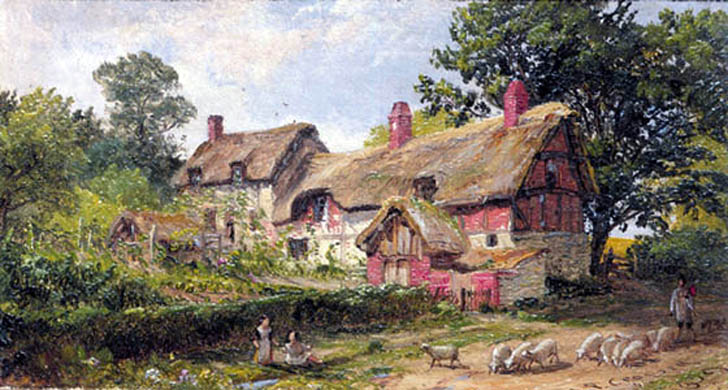
The Millennial Age: 1854
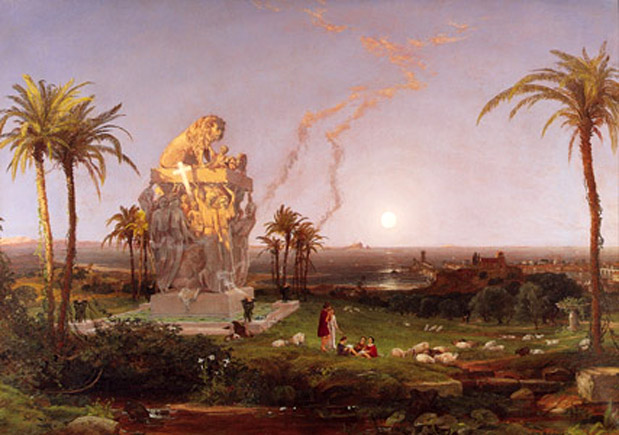
Days of Elizabeth: 1853
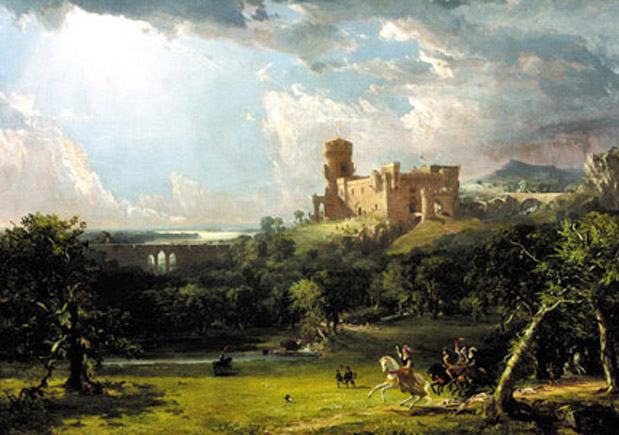
The Good Shepherd: 1855
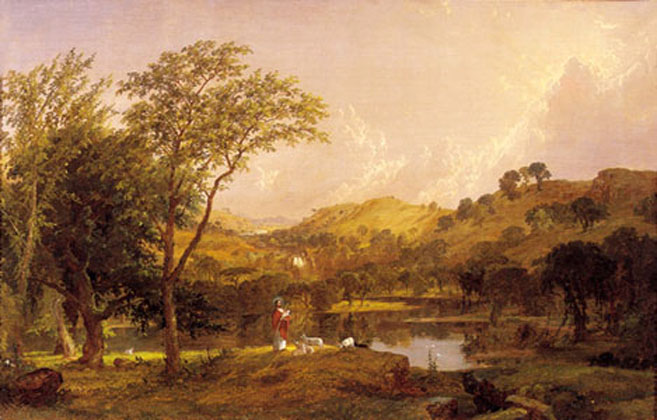
Newport Seascape: 1856

Springtime on the Hudson: 1856

Artist Painting the Hudson: 1872

Niagara Falls: 1853
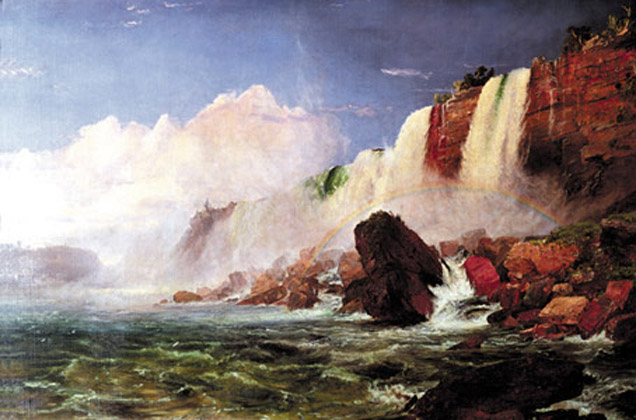
Catskill Mountain House: 1855
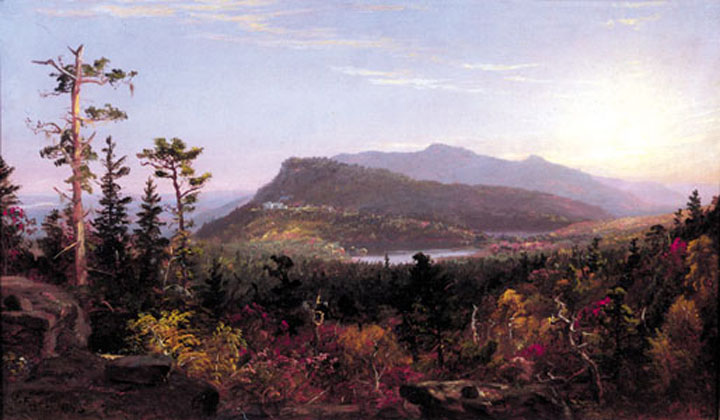
Mount Washington from Lake Sebago, Maine: 1875
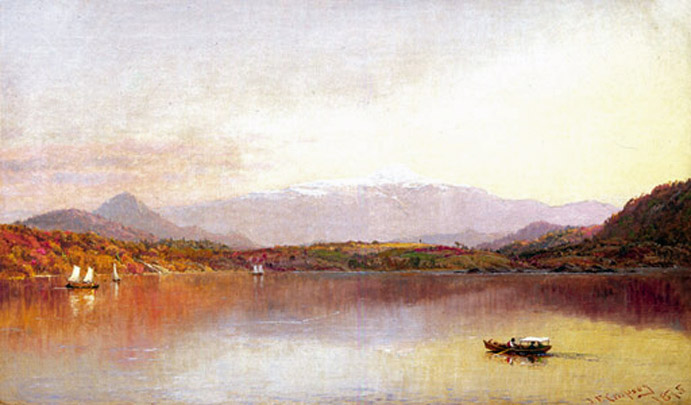
Pilgrim: 1849
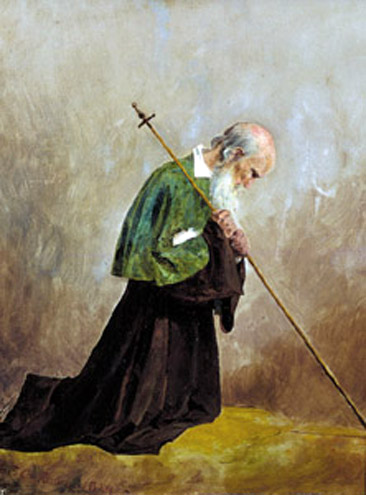
Study of a Donkey: 1865
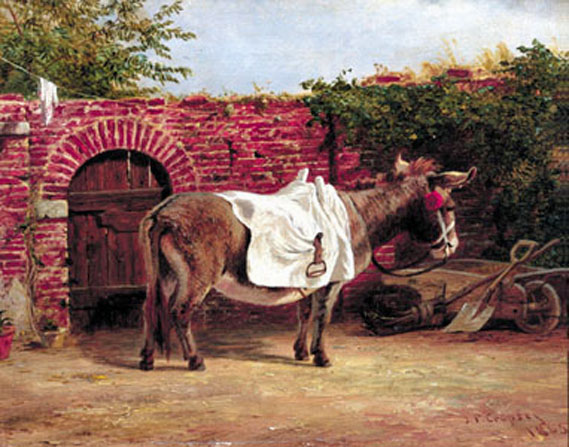
Florence: 1875

Source: Jasper Francis Cropsey Online
Source: Art Renewal Center Museum
Source: Newington Cropsey Foundation
Return to Pagina Artis
Return to Bruce and Bobbie's Main Page.